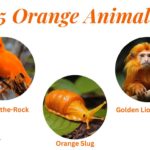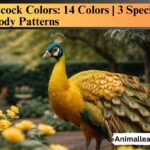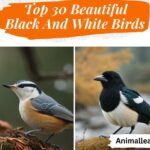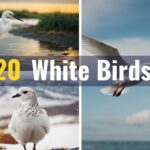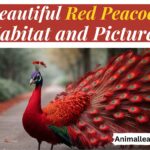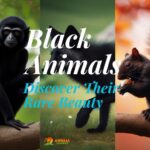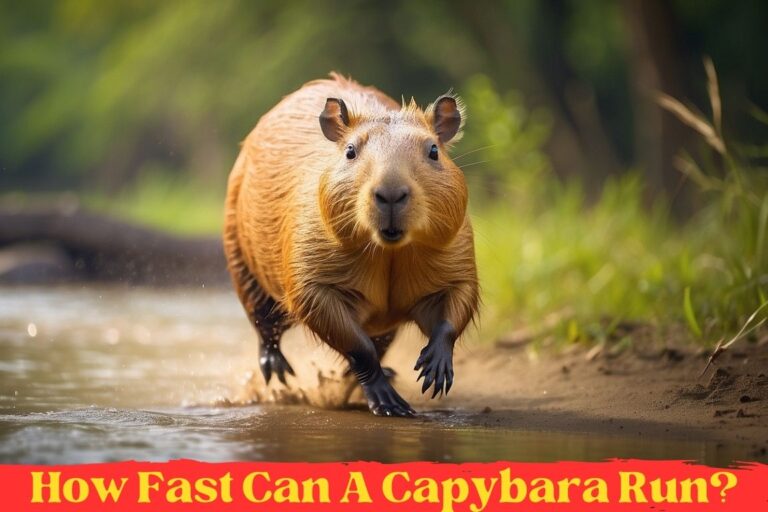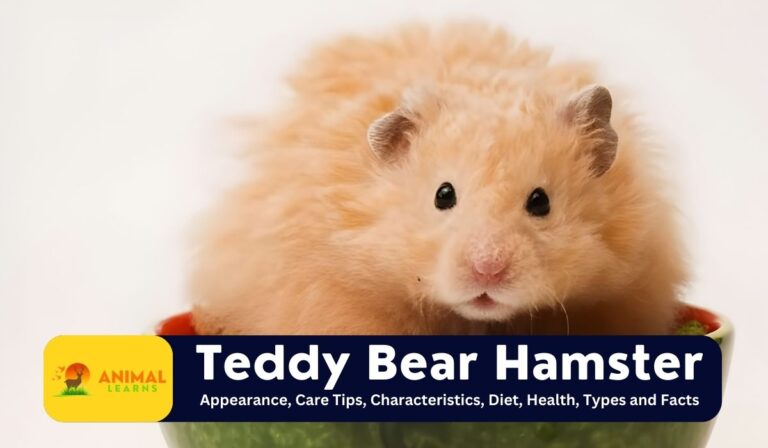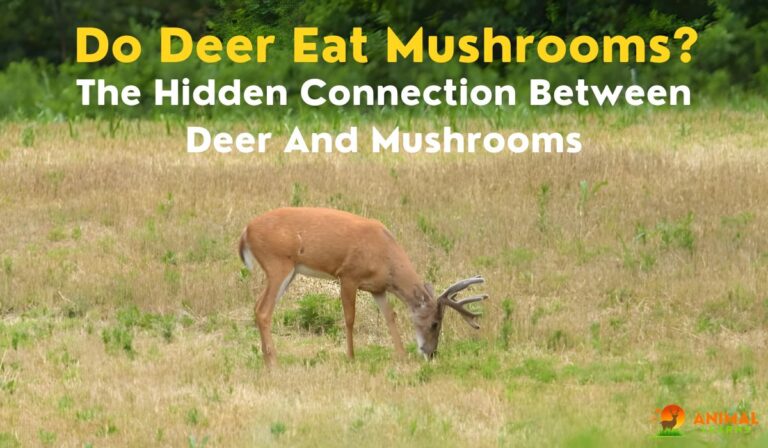50 Yellow Animals: Nature’s Brightest Wonders

Yellow animals bring a touch of vibrant sunshine to the natural world. When it comes to the animal kingdom, nature’s palette offers a wide range of colors. Among the most eye-catching and vivid of these hues is the color yellow.
Yellow, orange, black, and white animals exhibit a striking combination of colors in their fur or plumage, creating a captivating sight in nature.
Like black animals, white animals, and green animals make the environment beautiful, yellow animals, with their bright and cheerful hues, add a touch of vibrancy to the natural world.
From delicate canaries to venomous vipers, the world is home to a fascinating array of yellow animals that captivate with their unique beauty and adaptations.
Yellow Animals and Their Characteristics
Contents
- 1 Yellow Animals and Their Characteristics
- 2 The Diversity of Yellow Animals
- 3 Yellow Animals
- 3.1 Yellow Hamster
- 3.2 Yellow Mongoose
- 3.3 Yellow Baboon
- 3.4 Golden Lion Tamarin
- 3.5 Yellow Turtle
- 3.6 American Goldfinch
- 3.7 Misumena vatia
- 3.8 Eyelash Viper
- 3.9 Yellow Tang
- 3.10 Banana Slug
- 3.11 Yellow Seahorse
- 3.12 Yellow Warbler
- 3.13 Galapagos Land Iguana
- 3.14 Burmese Python
- 3.15 Golden Poison Frog
- 3.16 Panamanian Golden Frog
- 3.17 Climbing Mantella
- 3.18 Asian Golden Weaver
- 3.19 Nudibranch
- 3.20 Psyllobora Vigintiduopunctata
- 3.21 Ghost Crabs
- 3.22 Apple Snails
- 3.23 Fire Salamander
- 3.24 Yellowjacket
- 3.25 Crab Spiders
- 3.26 Yellow Boxfish
- 3.27 Great Tit
- 3.28 Western Tanager
- 3.29 Forceps Fish
- 3.30 Yellow-Banded Poison Dart Frog
- 3.31 Yellow Canary
- 3.32 Yellow-Breasted Chat
- 3.33 Neolamprologus Leleupi
- 3.34 Yellow-Crowned Bishop
- 3.35 Common Bluestripe Snapper
- 3.36 Brown Basilisk
- 3.37 Yellow Prawn-Goby
- 3.38 Notodoris Minor
- 3.39 Ahaetulla Nasuta
- 3.40 Lemonpeel Angelfish
- 3.41 Varanus Reisingeri
- 3.42 Diabrotica Undecimpunctata
- 3.43 Phoebis Argante
- 3.44 Old World Orioles
- 3.45 Sun Conure
- 3.46 Chrysaora Fuscescens
- 3.47 Sphaerophoria Scripta
- 3.48 Sulphur
- 3.49 Electric Yellow Cichlid
- 3.50 Butterflyfish
- 4 The Allure of Yellow in Nature
- 5 The Virtual and Real World of Yellow Animals
- 6 FAQs
Yellow animals, with their distinctively vibrant hue, hold a unique place in the animal kingdom. Some of them pose an interesting query: “What animal has yellow eyes?” These yellow-eyed animals captivate our curiosity, prompting us to explore which creatures possess these striking features and why.
The vivid yellow coloring of their eyes can be attributed to a variety of factors, encompassing pigmentation and environmental adaptations. Delving deeper into the world of Animal Characteristics, we uncover that certain animals not only have yellow eyes but also exhibit yellow blood and teeth, rendering them even more exceptional in the animal realm.
The Diversity of Yellow Animals
While some of these animals, like those inhabiting Yellowstone National Park, can perceive a diverse spectrum of colors, others, like those known for their bright yellow poop, may lack such visual capabilities.
This distinction raises intriguing questions about which animals can perceive the color yellow and which ones cannot. Moreover, gaining insights into the unique attributes of common Yellowstone animals and the plethora of species dwelling in Yellowstone National Park enriches our appreciation of the natural world.
In this comprehensive exploration, we’ll delve into the fascinating world of 50 stunning yellow animals from across the globe.
Yellow Animals
Yellow Hamster
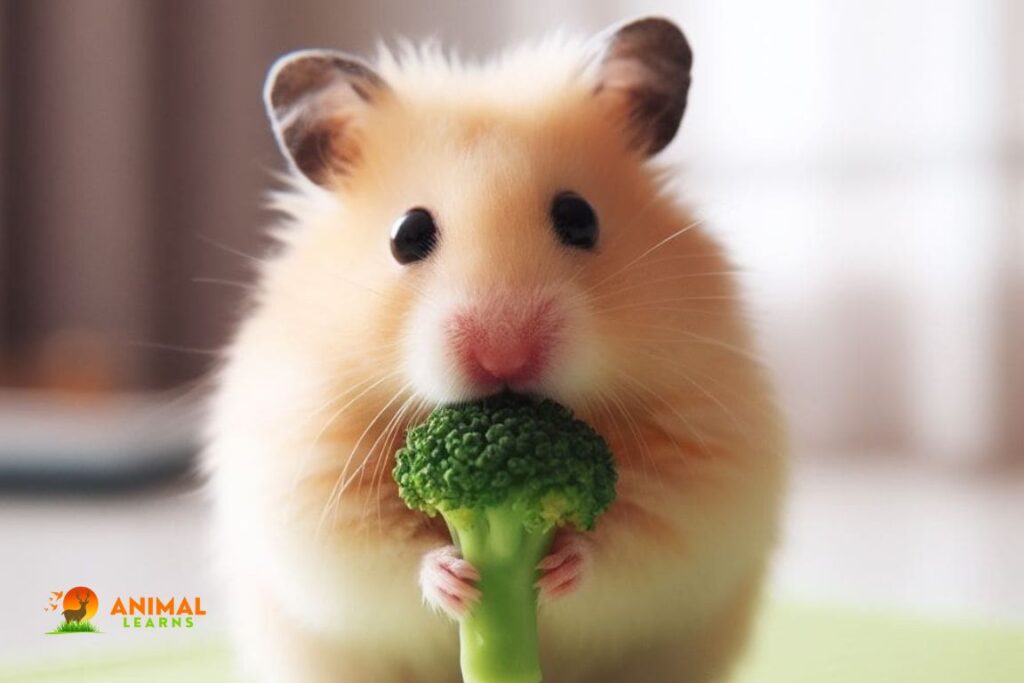
| Characteristic | Information |
| Scientific Name | Mesocricetus auratus |
| Fur Color | Yellowish-brown or golden |
| Size | 5-7 inches (adult) |
| Lifespan | 2-3 years (in captivity) |
| Diet | Seeds, vegetables, occasional fruits |
| Activity | Nocturnal |
| Special Behavior | Food hoarding in cheek pouches |
| Popular as Pet | Yes |
Yellow hamsters are a popular choice for small pets due to their friendly and social nature. These little critters have a golden or yellowish-brown coat with white bellies, making them an adorable addition to any family.
They are nocturnal creatures, meaning they are most active during the night. Yellow hamsters enjoy a diet of seeds, vegetables, and occasional fruits.
Yellow Mongoose

| Characteristic | Information |
| Scientific Name | Cynictis penicillata |
| Fur Color | Yellowish-brown |
| Size | 8-10 inches (body), 7-12 inches (tail) |
| Lifespan | 5-8 years (in the wild) |
| Diet | Insects, small rodents, fruits |
| Activity | Diurnal |
| Social Behavior | Group-living |
| Habitat | Grasslands, open habitats |
The yellow mongoose is a fascinating carnivorous mammal native to southern Africa. These mongooses have striking yellowish-brown fur and a slender, elongated body that makes them stand out in the wild.
Yellow mongooses feed primarily on insects, small rodents, and occasionally fruits. They are often found in grasslands and open habitats where they can forage for food.
Yellow Baboon
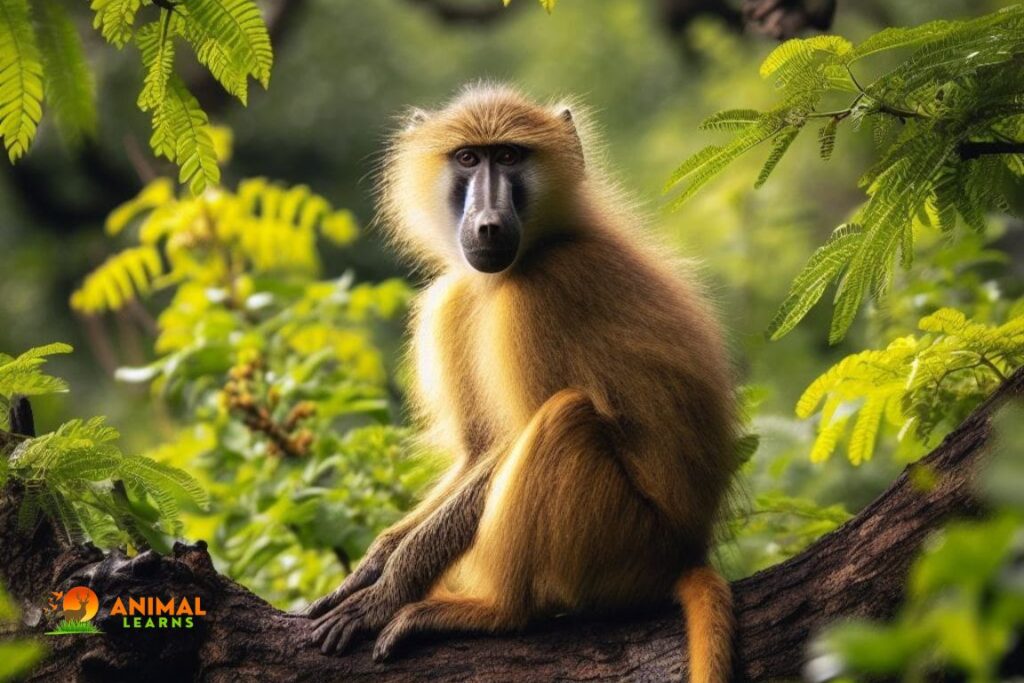
| Characteristic | Information |
| Scientific Name | Papio cynocephalus |
| Fur Color | Yellow-brown |
| Size | Males: 30-40 inches (body), Females: Slightly smaller |
| Lifespan | 20-30 years (in the wild) |
| Diet | Omnivorous |
| Social Structure | Troops with complex hierarchy |
| Communication | Vocalizations, body language |
| Range | Africa |
The yellow baboon is a fascinating primate native to Africa. These large primates have distinctive yellow-brown fur and live in social groups called troops, which can consist of up to 200 individuals. Yellow baboons are omnivorous, feeding on a variety of foods such as fruits, leaves, insects, and small vertebrates.
These primates are known for their complex social hierarchies and sophisticated communication through vocalizations and body language.
Golden Lion Tamarin
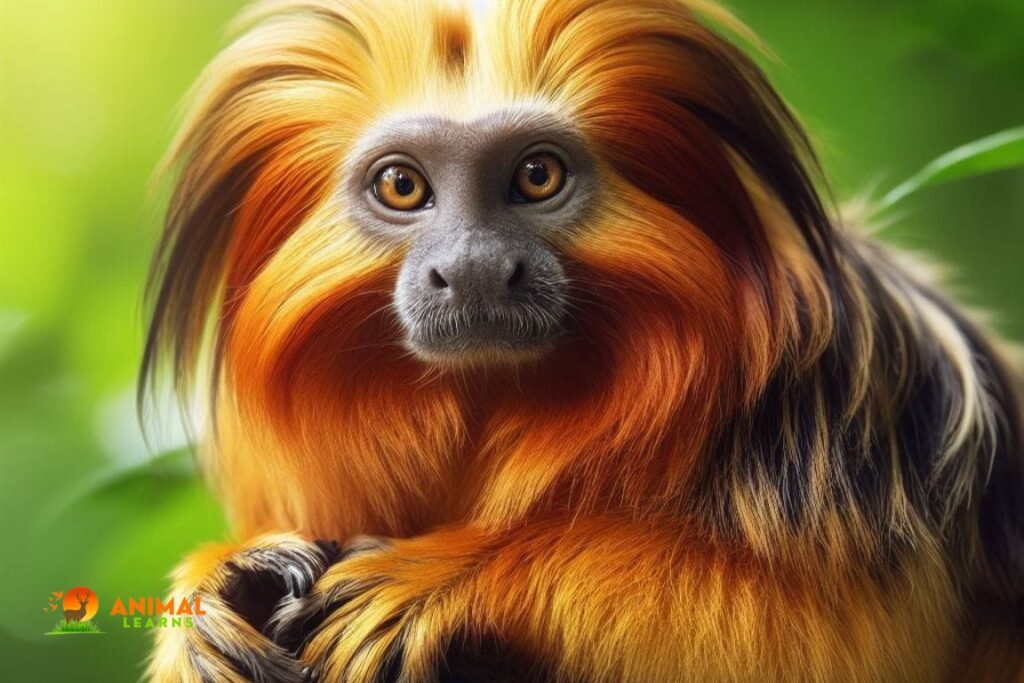
| Characteristic | Information |
| Scientific Name | Leontopithecus rosalia |
| Fur Color | Reddish-gold to orange |
| Size | 8-12 inches (body), 12-15 inches (tail) |
| Lifespan | 8-15 years (in the wild) |
| Diet | Fruits, insects, tree sap |
| Conservation Status | Critically Endangered |
| Conservation Efforts | Habitat protection, breeding programs |
| Native Range | Atlantic coastal forests of Brazil |
Yellow animals, with their golden and sunny appearances, are nature’s living masterpieces. Top of Form The golden lion tamarin is a fascinating primate that calls the Atlantic coastal forests of Brazil its home. These small, critically endangered creatures are known for their striking reddish-gold to orange fur and distinctive manes that give them a regal appearance.
They are primarily fruit eaters but also enjoy insects and tree sap. Unfortunately, their population has drastically declined due to habitat loss and illegal wildlife trade, making conservation efforts crucial for their survival.
Yellow Turtle
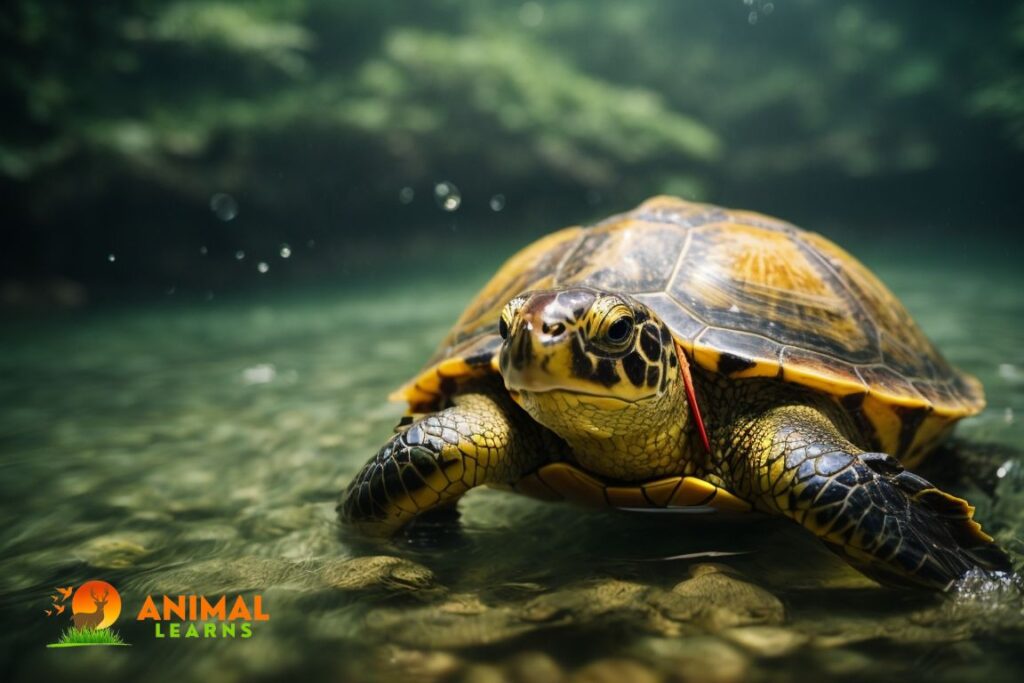
| Characteristic | Information |
| Coloration | Yellow or yellowish hue on shell or skin |
| Rarity | Uncommon |
| Behavior | Similar to other turtle species |
| Conservation Status | Protection of habitats |
| Habitat | Various ecosystems worldwide |
| Genetic Variation | Possible cause of yellow coloration |
Yellow turtles are a rare and unusual phenomenon in the animal kingdom. These reptiles can have a yellowish hue on their shells or skin due to genetic variations or environmental factors. While not an official species, yellow turtles are occasionally found in various parts of the world.
Their yellow coloration is distinctive but doesn’t significantly affect their behavior or ecology. It’s essential to protect these unique individuals and their habitats to ensure their continued survival.
American Goldfinch
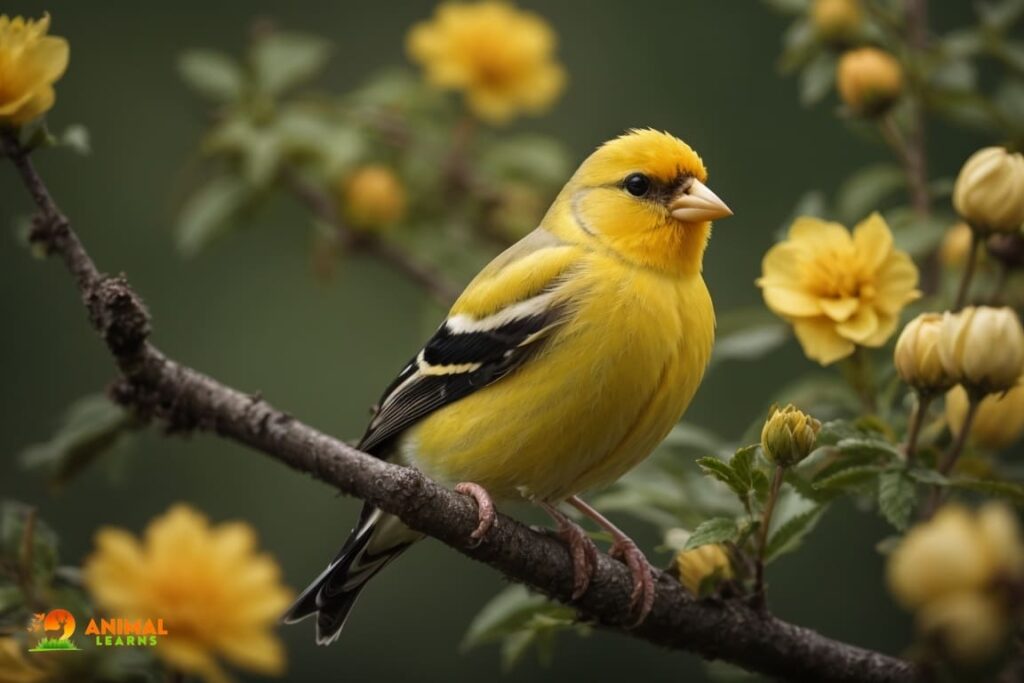
| Information | Details |
| Scientific Name | Spinus tristis |
| Group | Bird |
| Habitat | North and Central America |
| Seasonal Color | Males turn bright yellow in summer |
| Size | About 4.3 to 5.1 inches (11-13 cm) |
| Weight | Approximately 0.4 to 0.7 ounces |
| Location | Various regions in North America |
The American Goldfinch, Spinus tristis, is often referred to as the “wild canary.” These small birds are renowned for their striking seasonal transformations. During the breeding season, males don a brilliant lemon-yellow plumage, while females and juveniles sport a more subdued olive-brown hue. This sexual dimorphism serves both as camouflage for nesting females and as a means for males to attract mates.
Misumena vatia

| Information | Details |
| Scientific Name | Misumena vatia |
| Group | Arachnid (Spider) |
| Habitat | North America and Europe |
| Color Change Ability | Can change color to match flowers |
| Size | About 0.2 to 0.4 inches (5-10 mm) |
| Unique Feature | Camouflages itself on flowers |
The Misumena Vatia, also known as the “Goldenrod Crab Spider,” is a master of camouflage. These small arachnids have the astonishing ability to change their color to match the flowers they inhabit.
When positioned on a yellow flower, they can transition from white to yellow in a matter of days. This adaptive camouflage aids in ambushing unsuspecting pollinators.
Eyelash Viper
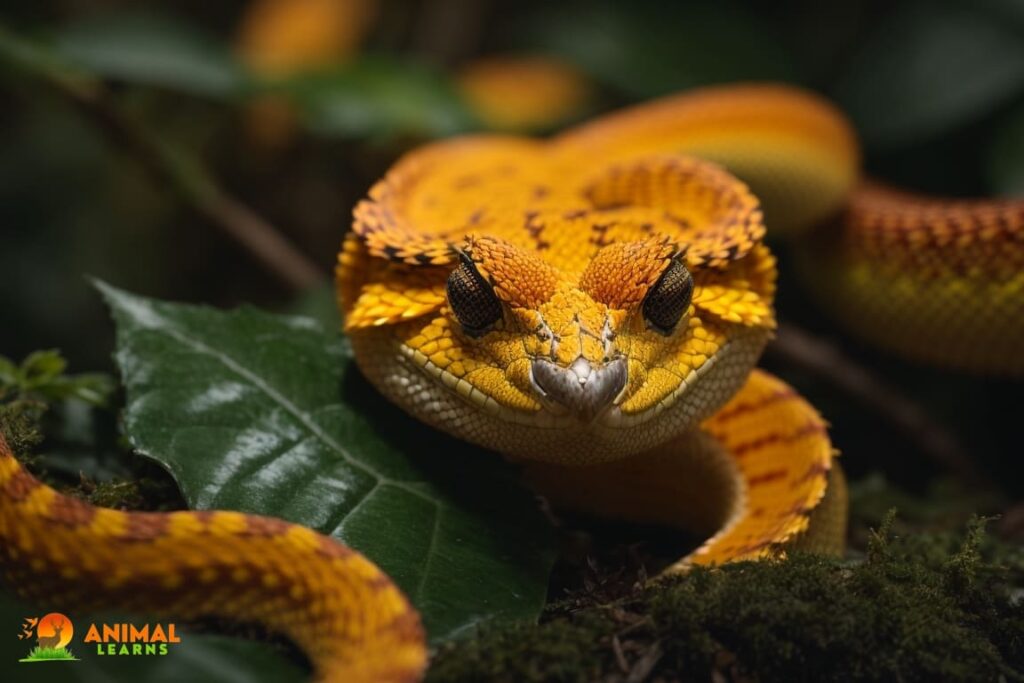
| Information | Details |
| Scientific Name | Bothriechis schlegelii |
| Group | Reptile (Snake) |
| Habitat | Central and South America |
| Coloration | Yellow-green with eyelash-like scales |
| Size | About 24 to 32 inches (61-81 cm) |
| Unique Feature | Eyelash-like scales above eyes |
Found in the dense rainforests of Central and South America, the Eyelash Viper, Bothriechis schlegelii, is a mesmerizing but venomous snake. Its vibrant yellow-green scales provide effective camouflage among the lush foliage.
One of its distinctive features is the presence of modified scales above its eyes that resemble eyelashes, giving it a unique and alluring appearance.
Yellow Tang
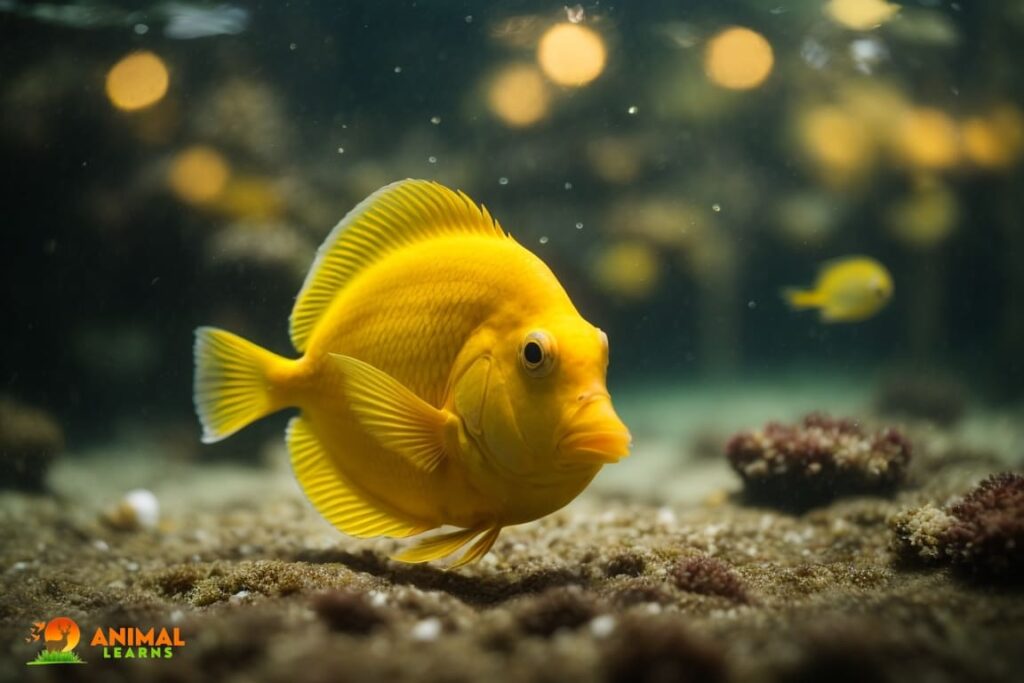
| Information | Details |
| Scientific Name | Zebrasoma flavescens |
| Group | Fish |
| Habitat | Pacific Ocean, coral reefs |
| Coloration | Bright yellow body with black bar |
| Size | Up to 8 inches (20 cm) |
| Unique Feature | Vibrant coloration for recognition |
In the azure waters of the Pacific Ocean, the Yellow Tang, Zebrasoma flavescens, is a beloved sight among divers and aquarists. These graceful fish feature a lemon-yellow body adorned with a prominent black bar at the base of their tail fin. Their vivid coloration serves multiple purposes, including species recognition and signaling their health to potential mates.
Banana Slug
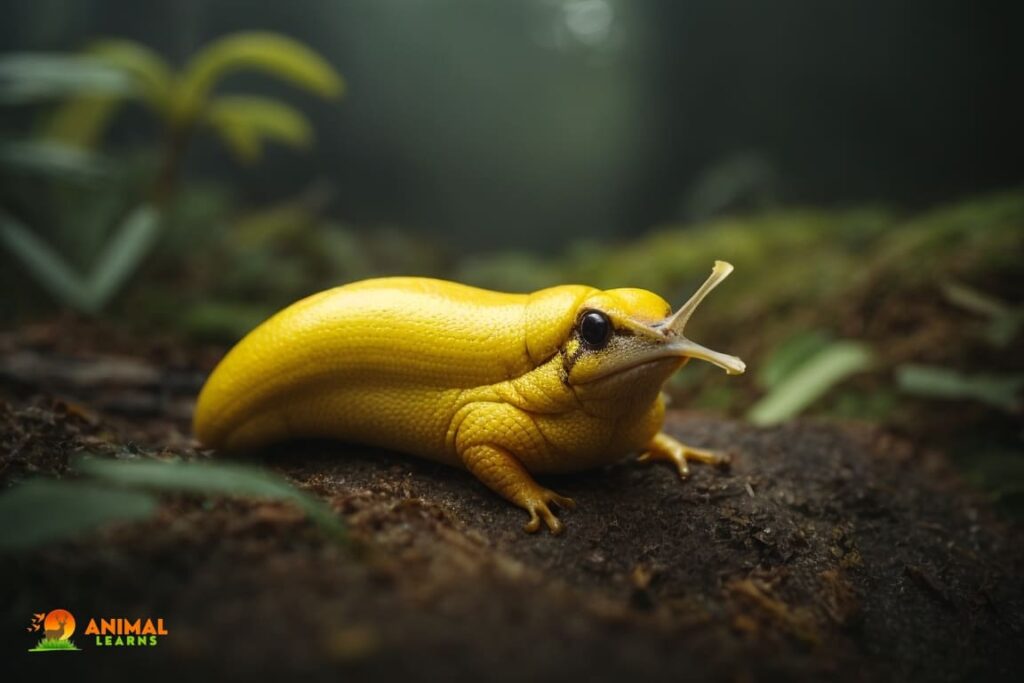
| Information | Details |
| Scientific Name | Ariolimax dolichophallus |
| Group | Gastropod (Mollusk) |
| Habitat | Moist forests of North America |
| Coloration | Bright yellow |
| Size | Can reach up to 10 inches (25 cm) |
| Unique Feature | Yellow color serves as a warning |
In the cool, moist forests of North America, you may encounter the fascinating Banana Slug, Ariolimax dolichophallus. Named for its elongated, banana-like shape, these terrestrial gastropods exhibit a striking yellow hue. Their vibrant color serves as a warning to predators since they are known to exude mucus that contains toxins, making them unpalatable.
Yellow Seahorse
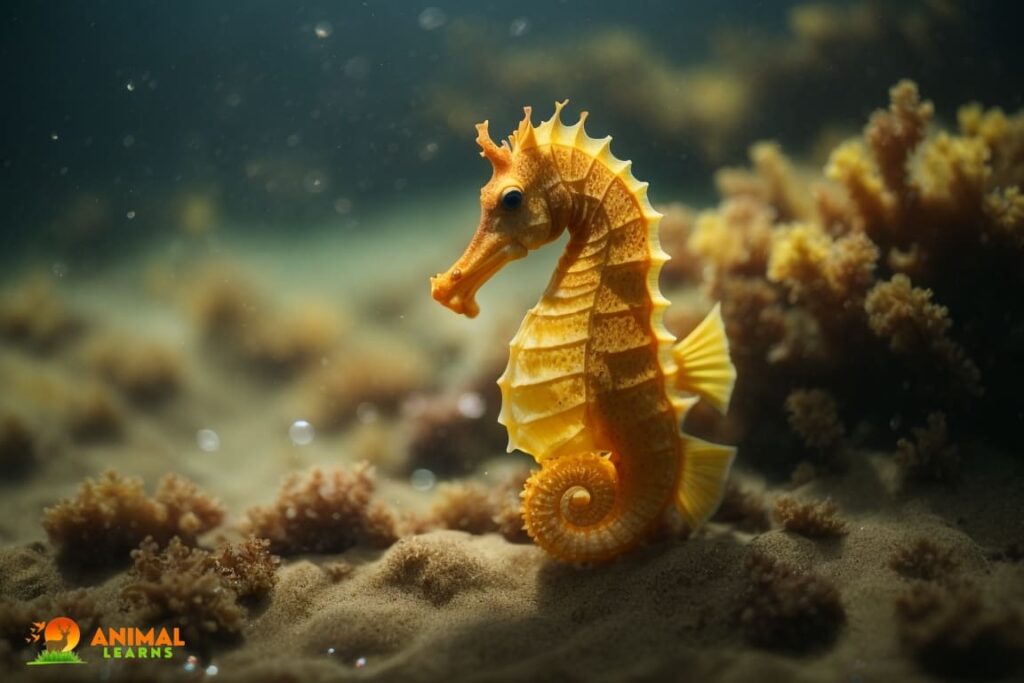
| Information | Details |
| Scientific Name | Hippocampus kuda |
| Group | Fish (Seahorse) |
| Habitat | Indo-Pacific coral reefs |
| Coloration | Bright yellow |
| Size | About 3 to 4 inches (7.6-10 cm) |
| Unique Feature | Camouflage in coral reef habitats |
Venturing into the mysterious world beneath the waves, the Yellow Seahorse, Hippocampus Kuda, captivates with its unique appearance. These small, upright-swimming fish belong to the seahorse family.
Their bright yellow coloration, combined with intricate patterns, allows them to blend seamlessly into the vibrant coral reefs they call home. Seahorses are known for their monogamous behavior and the remarkable role males play in pregnancy.
Yellow Warbler
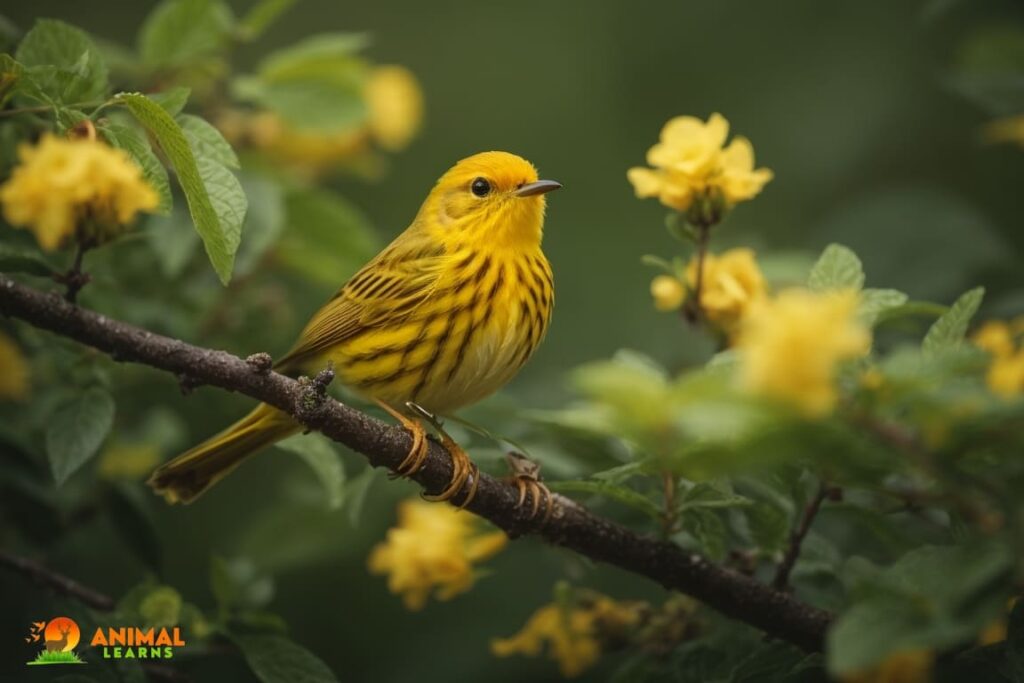
| Information | Details |
| Scientific Name | Setophaga petechia |
| Group | Bird |
| Habitat | North America |
| Seasonal Color | Bright yellow in breeding season |
| Size | About 4.3 to 5.1 inches (11-13 cm) |
| Weight | Approximately 0.4 to 0.5 ounces |
The Yellow Warbler, Setophaga petechia, is a delightful songbird native to North and Central America. While it may not possess the showiest of yellow plumage, its vibrant lemon-yellow feathers, and cheerful melodies make it a favorite among birdwatchers. These warblers are often spotted flitting among the leaves of deciduous trees during the breeding season.
Galapagos Land Iguana
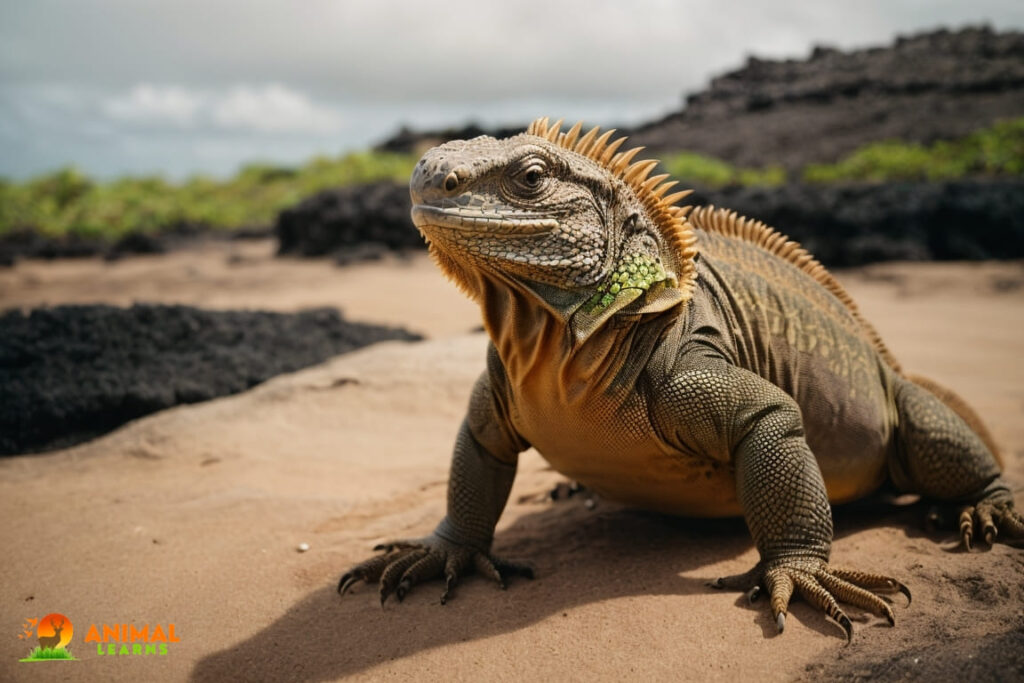
| Information | Details |
| Scientific Name | Conolophus subcristatus |
| Group | Reptile (Iguana) |
| Habitat | Galapagos Islands |
| Coloration | Bright yellow with black markings |
| Size | Up to 3.3 feet (1 meter) |
| Weight | Around 25 pounds (11 kg) |
Native to the Galapagos Islands, the Galapagos Land Iguana, Conolophus subcristatus, is a remarkable reptile. These ancient creatures are often seen basking in the sun, showcasing their golden-yellow skin.
Their coloration helps them blend into the arid landscapes of the Galapagos, where they feed on cactus pads and other vegetation. These iguanas are a living testament to the unique biodiversity of the islands.
Burmese Python
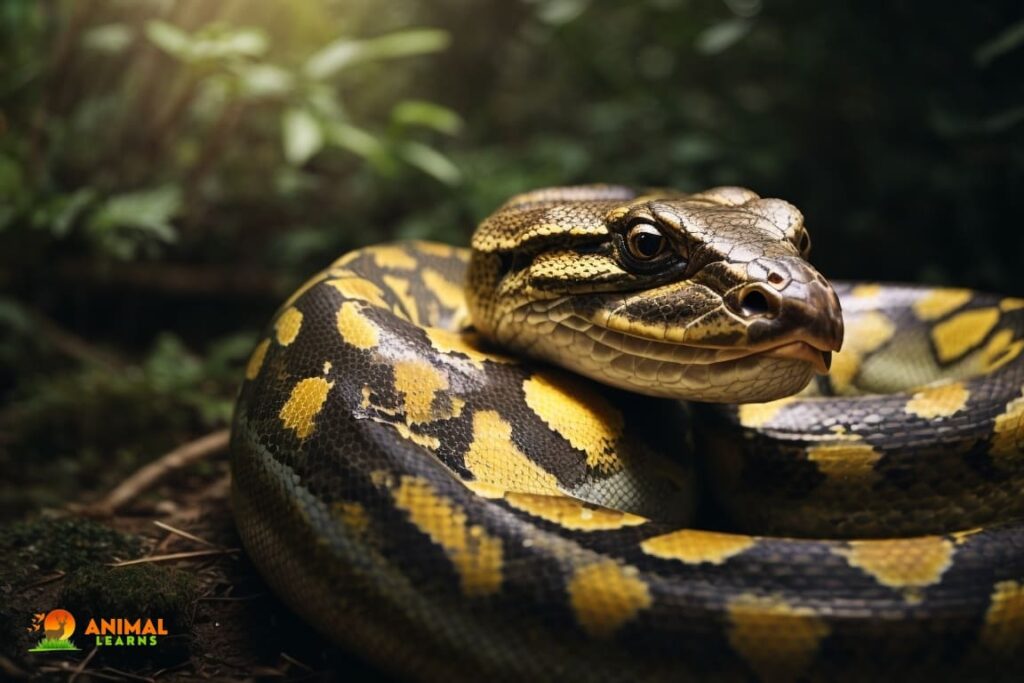
| Information | Details |
| Scientific Name | Python bivittatus |
| Group | Reptile (Snake) |
| Habitat | Southeast Asia |
| Coloration | Yellowish-brown with dark patterns |
| Size | Can exceed 23 feet (7 meters) |
| Weight | Up to 200 pounds (90 kg) |
The Burmese Python, Python bivittatus, is one of the world’s largest snake species, capable of reaching lengths of over 20 feet. Native to Southeast Asia, these reptiles often exhibit yellowish-brown scales with dark blotches.
Their striking appearance has made them popular in the exotic pet trade, although their ownership is subject to strict regulations in many regions.
Golden Poison Frog

| Information | Details |
| Scientific Name | Phyllobates terribilis |
| Group | Amphibian (Frog) |
| Habitat | Western Colombia |
| Coloration | Bright yellow with black spots |
| Size | Approximately 1.5 inches (4 cm) |
Hailing from the rainforests of Colombia, the Golden Poison Frog, Phyllobates terribilis, is as dazzling as it is deadly. Its golden skin, adorned with black spots and stripes, serves as a warning to potential predators. These frogs are among the most toxic animals on Earth, with toxins that indigenous people have used for centuries to poison the tips of blow darts.
Panamanian Golden Frog
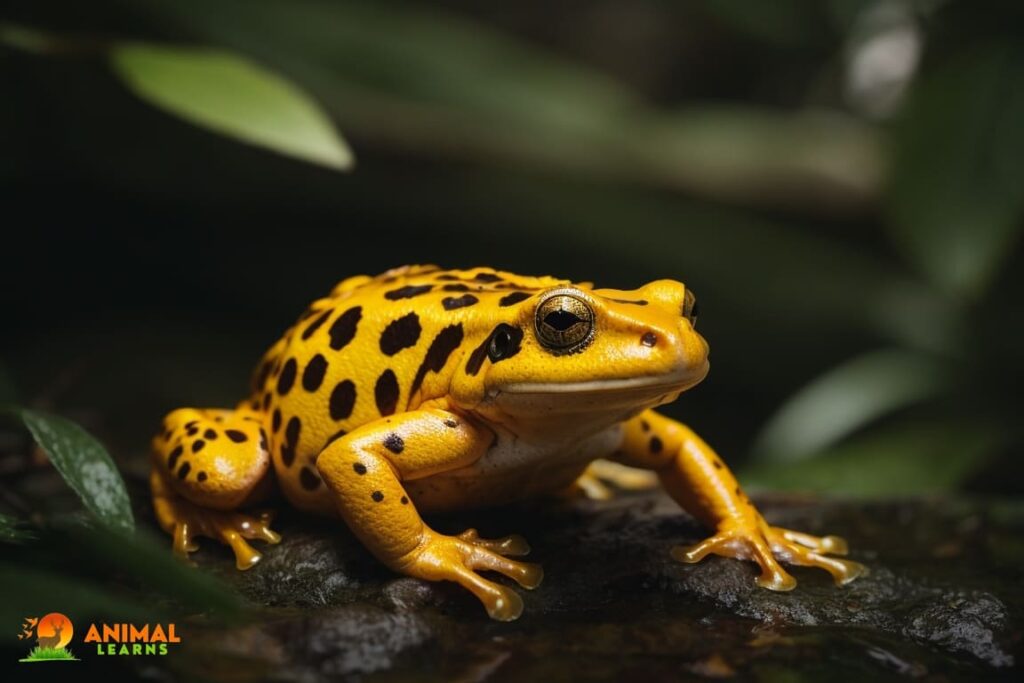
| Information | Details |
| Scientific Name | Atelopus zeteki |
| Group | Amphibian (Frog) |
| Habitat | Western Panama |
| Coloration | Bright yellow to orange |
| Size | About 1.5 inches (3.8 cm) |
| Unique Feature | Highly toxic skin secretion |
Endemic to Panama, the Panamanian Golden Frog, Atelopus zeteki, is an iconic amphibian facing a critical threat of extinction. Its bright yellow coloration and contrasting black spots make it a symbol of conservation efforts in the region. These frogs are an essential part of the fragile ecosystems in which they reside.
Climbing Mantella

| Information | Details |
| Scientific Name | Mantella laevigata |
| Group | Amphibian (Frog) |
| Habitat | Madagascar |
| Coloration | Yellow with black markings |
| Size | Approximately 0.8 inches (2 cm) |
Found exclusively on the island of Madagascar, the Climbing Mantella, Mantella laevigata, is a small but striking yellow frog. Its bright coloration is a warning to potential predators, as it secretes toxins through its skin. These toxins are derived from the insects they consume, making them unpalatable to would-be assailants.
Asian Golden Weaver
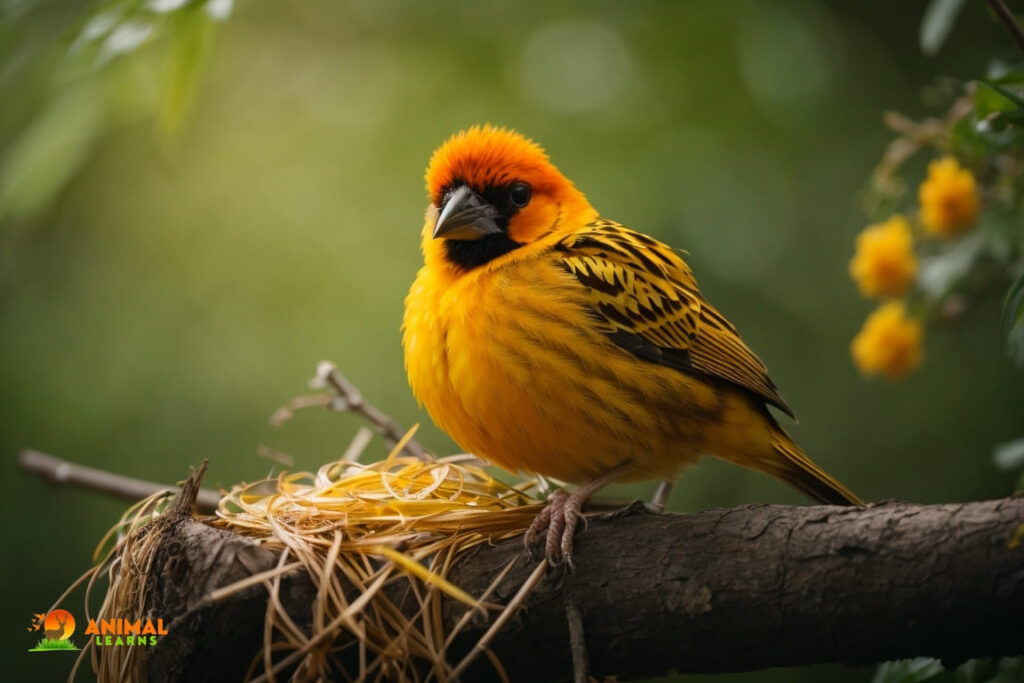
| Information | Details |
| Scientific Name | Ploceus hypoxanthus |
| Group | Bird |
| Habitat | Southeast Asia |
| Plumage | Bright yellow |
| Size | About 5.5 inches (14 cm) |
The Asian Golden Weaver, Ploceus hypoxanthus, is a remarkable bird known for its exceptional nest-building skills. During the breeding season, the males undergo a transformation, displaying striking yellow plumage. These master weavers construct intricate nests, often resembling hanging baskets, which serve as both shelter and displays to attract potential mates.
Nudibranch
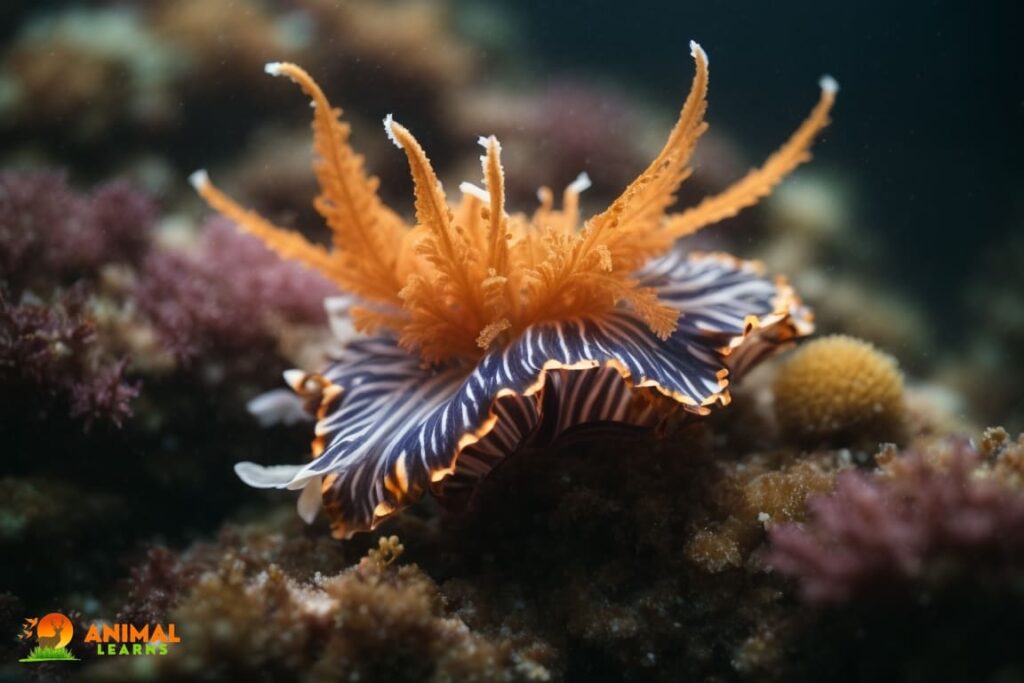
| Information | Details |
| Scientific Name | Various species |
| Group | Marine Invertebrate |
| Habitat | Oceans worldwide |
| Coloration | Yellow, often with vibrant patterns |
| Size | Varies by species |
Beneath the shimmering surface of the ocean lies a hidden world of exquisite creatures, including the captivating Nudibranchs. These marine mollusks are renowned for their striking colors and intricate patterns. One example is the Chromodoris annae, which boasts vibrant yellow and purple markings. Their vibrant appearance adds to the vibrant tapestry of life on coral reefs.
Psyllobora Vigintiduopunctata
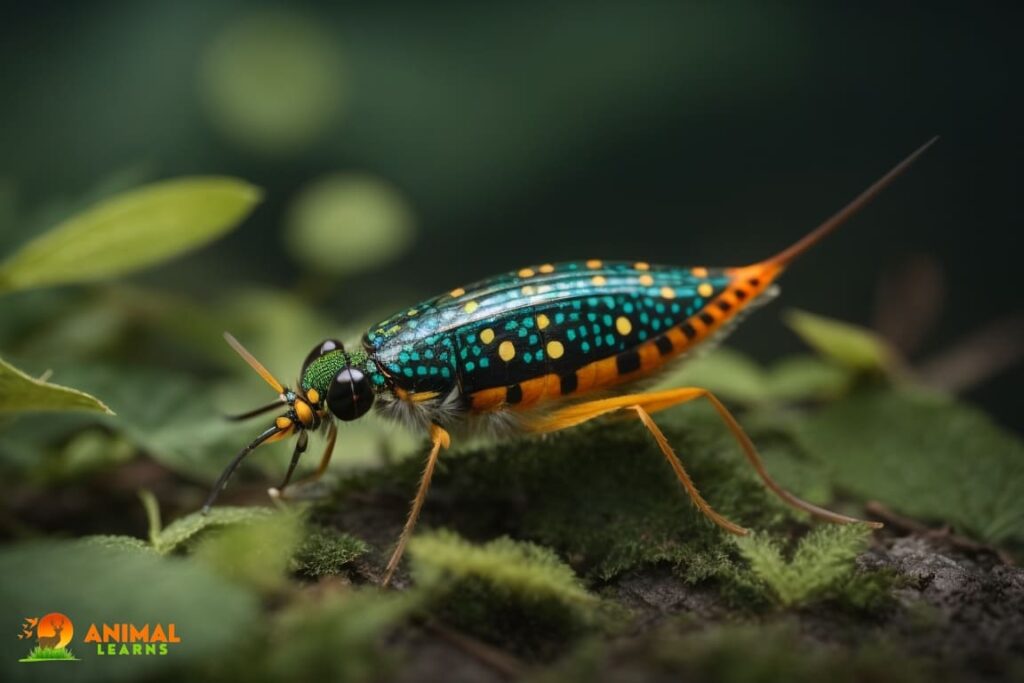
| Information | Details |
| Scientific Name | Psyllobora vigintiduopunctata |
| Group | Insect (Lady Beetle) |
| Habitat | North America |
| Coloration | Yellow with black spots |
| Size | Tiny, less than 0.2 inches (5 mm) |
The diminutive Psyllobora Vigintiduopunctata, commonly known as the 22-spot ladybug, is a tiny yellow beetle adorned with charming black spots. These gentle insects are celebrated for their role as natural pest controllers in gardens. They feed on aphids and other garden pests, making them beneficial to plants and crops.
Ghost Crabs
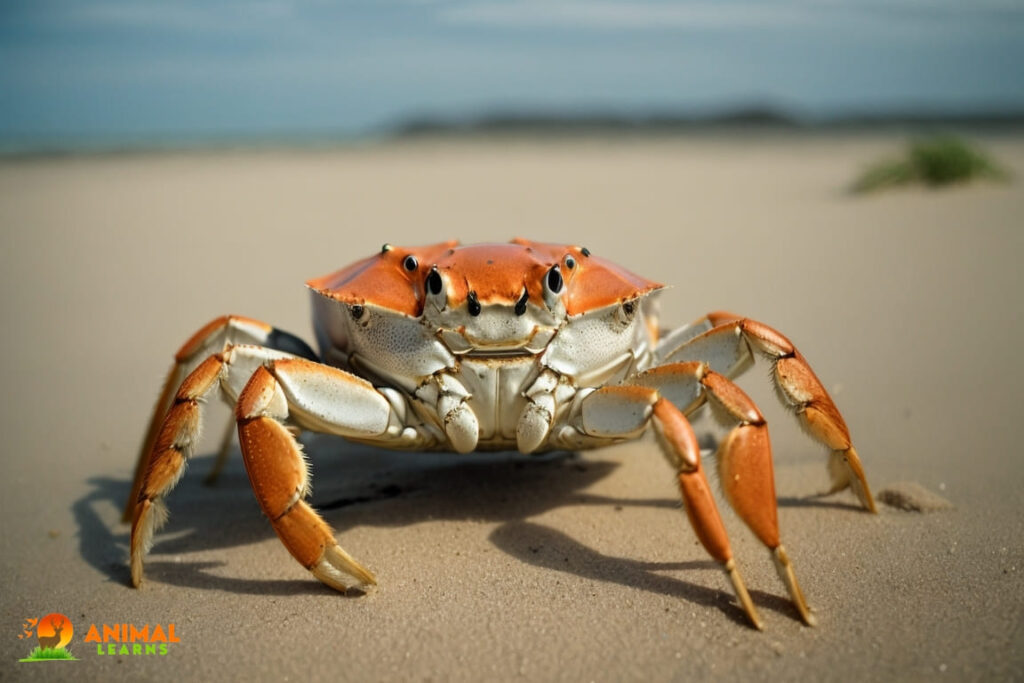
| Information | Details |
| Scientific Name | Ocypode spp. |
| Group | Crustacean (Crab) |
| Habitat | Coastal regions worldwide |
| Coloration | Yellow to pale colors |
| Size | Varies by species, typically small |
Along the world’s sandy coastlines, Ghost Crabs make their homes. These small crustaceans are named for their pale yellow-to-white coloration and their remarkable ability to disappear quickly into burrows in the sand. Their keen sense of vision and impressive speed make them a challenge to spot during the day.
Apple Snails

| Information | Details |
| Scientific Name | Pomacea spp. |
| Group | Mollusk (Snail) |
| Habitat | Freshwater habitats worldwide |
| Coloration | Yellowish shells |
| Size | Shell size varies, can be large |
Apple Snails are freshwater gastropods known for their golden-yellow shells. These snails play a vital role in aquatic ecosystems by grazing on algae, helping maintain the health of their habitats. Their shells are not only functional but also aesthetically pleasing with their radiant coloration.
Fire Salamander

| Information | Details |
| Scientific Name | Salamandra salamandra |
| Group | Amphibian (Salamander) |
| Habitat | Europe and parts of Asia |
| Coloration | Black with bright yellow or orange |
| Size | Typically 6 to 8 inches (15-20 cm) |
Yellow animals like the Fire Salamander, Salamandra is a distinctive amphibian with bold yellow and black markings. Found in parts of Europe, these creatures have long been the subject of folklore and legends. In reality, they are a crucial part of the forest ecosystem, helping to control insect populations.
Yellowjacket

| Information | Details |
| Scientific Name | Various species |
| Group | Insect (Wasp) |
| Habitat | Worldwide |
| Coloration | Yellow and black |
| Size | Varies by species, typically small |
Yellowjackets are aggressive wasps known for their yellow and black striped appearance. These insects are notorious for their painful stings and are often encountered during picnics and outdoor gatherings. Despite their reputation, they play a role in pollination and pest control.
Crab Spiders

| Information | Details |
| Scientific Name | Various species |
| Group | Arachnid (Spider) |
| Habitat | Worldwide |
| Coloration | Yellow with varying patterns |
| Size | Varies by species |
Crab Spiders encompass a diverse group of arachnids, and some species display vibrant yellow hues. These spiders are masters of camouflage, often changing color to match the flowers they hide on. Their appearance makes them formidable ambush predators, waiting patiently for unsuspecting prey.
Yellow Boxfish
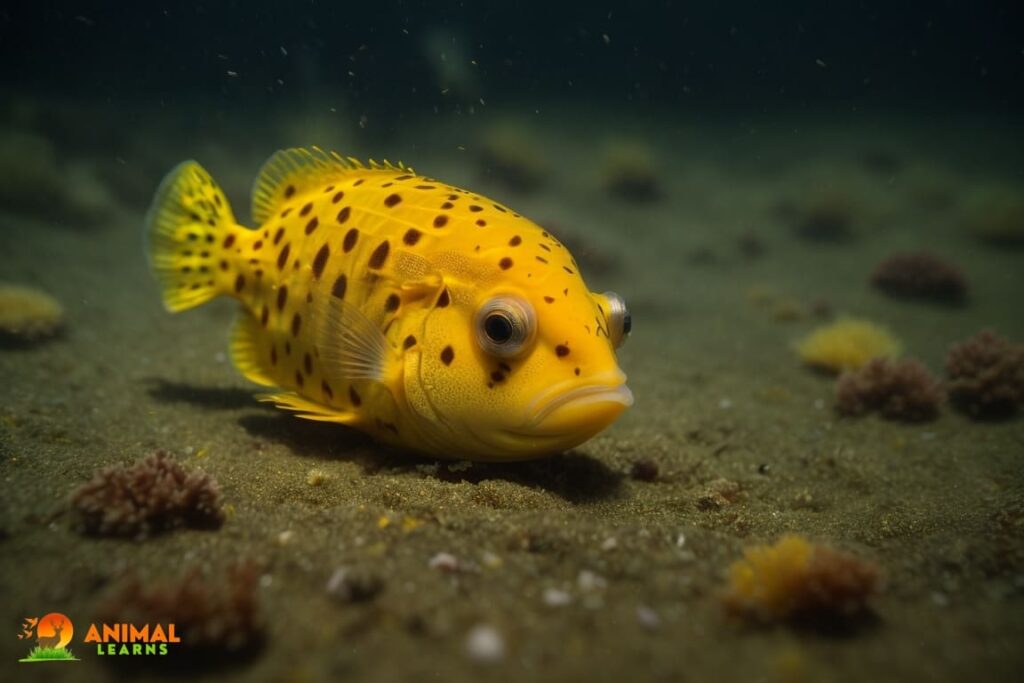
| Information | Details |
| Scientific Name | Ostracion cubicus |
| Group | Fish |
| Habitat | Tropical coral reefs |
| Coloration | Bright yellow with black spots |
| Size | About 4 to 7 inches (10-18 cm) |
The Yellow Boxfish, Ostracion cubicus, is a small, box-shaped marine fish known for its vivid yellow coloration. Their unique shape and color serve as a warning to potential predators. They are often found in coral reefs, where their slow-moving nature belies their resilience.
Great Tit
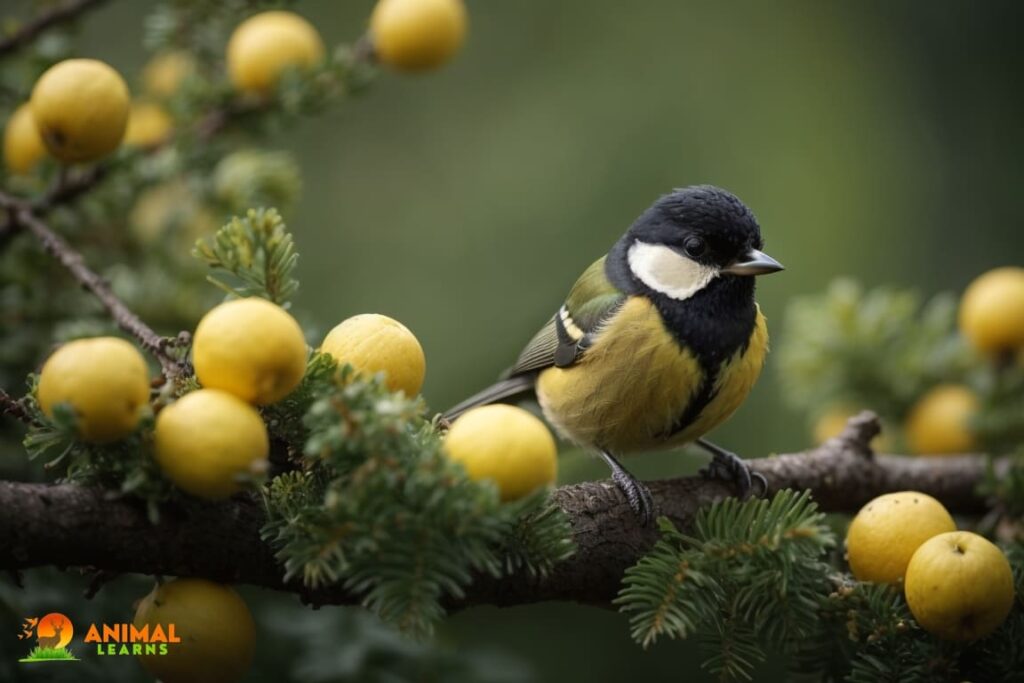
| Information | Details |
| Scientific Name | Parus major |
| Group | Bird |
| Habitat | Europe, Asia, and parts of Africa |
| Plumage | Yellow breast with black markings |
| Size | About 4.7 to 5.5 inches (12-14 cm) |
Among the many shades in the animal kingdom, the vibrant yellows of these creatures stand out. The Great Tit, Parus major, is a common songbird across Europe and Asia.
It features a striking combination of bright yellow plumage with distinctive black markings on its head and wings. These agile birds are known for their acrobatic antics as they navigate through trees in search of insects and seeds.
Western Tanager
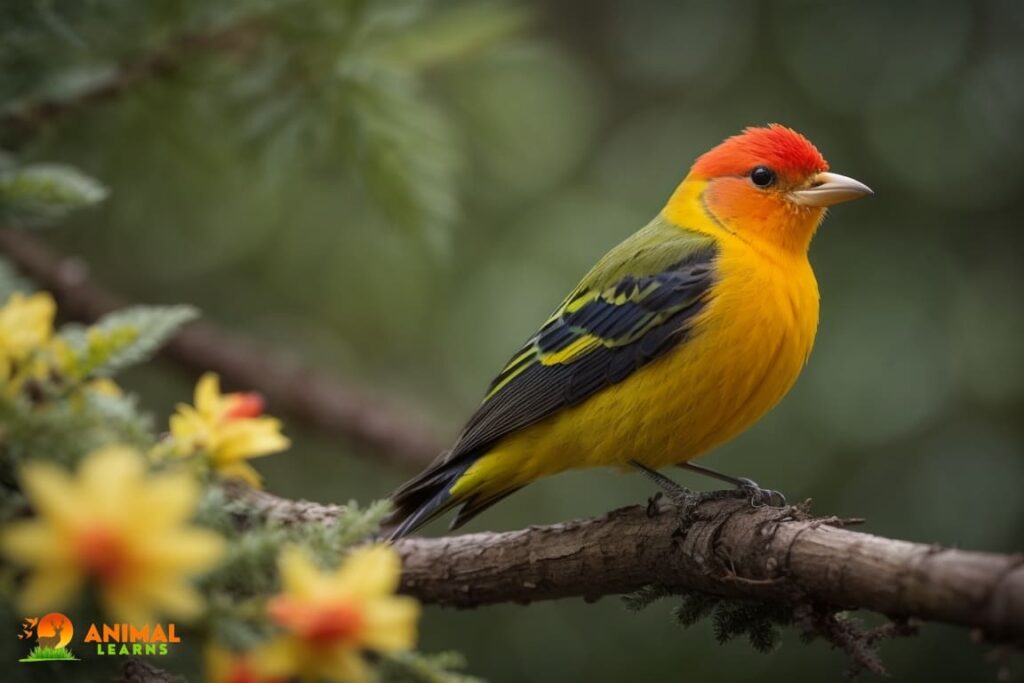
| Information | Details |
| Scientific Name | Piranga ludoviciana |
| Group | Bird |
| Habitat | North and Central America |
| Plumage | Bright yellow body with black wings |
| Size | Approximately 7 inches (18 cm) |
The Western Tanager, Piranga ludoviciana, is a stunning bird native to North America. Males showcase an exquisite blend of bright yellow plumage, contrasted by bold black wings and a vibrant red face. Their melodious calls resonate through the forests, making them a sought-after sight for birdwatchers.
Forceps Fish
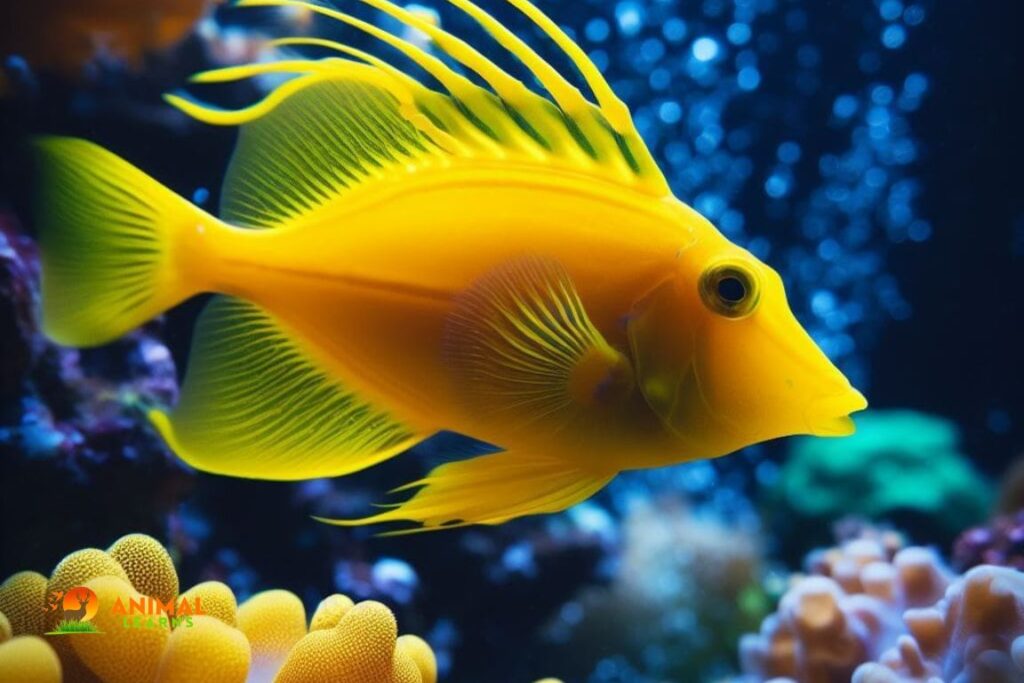
| Information | Details |
| Scientific Name | Various species |
| Group | Fish |
| Habitat | Deep ocean abyss |
| Coloration | Bright yellow |
| Size | Varies by species |
In the depths of the ocean’s abyss, the Forceps Fish thrives. Its striking yellow coloration allows it to blend seamlessly into the dark, mysterious environment. These fish are equipped with unique elongated jaws that resemble forceps, which they use to catch prey in the pitch-black depths.
Yellow-Banded Poison Dart Frog
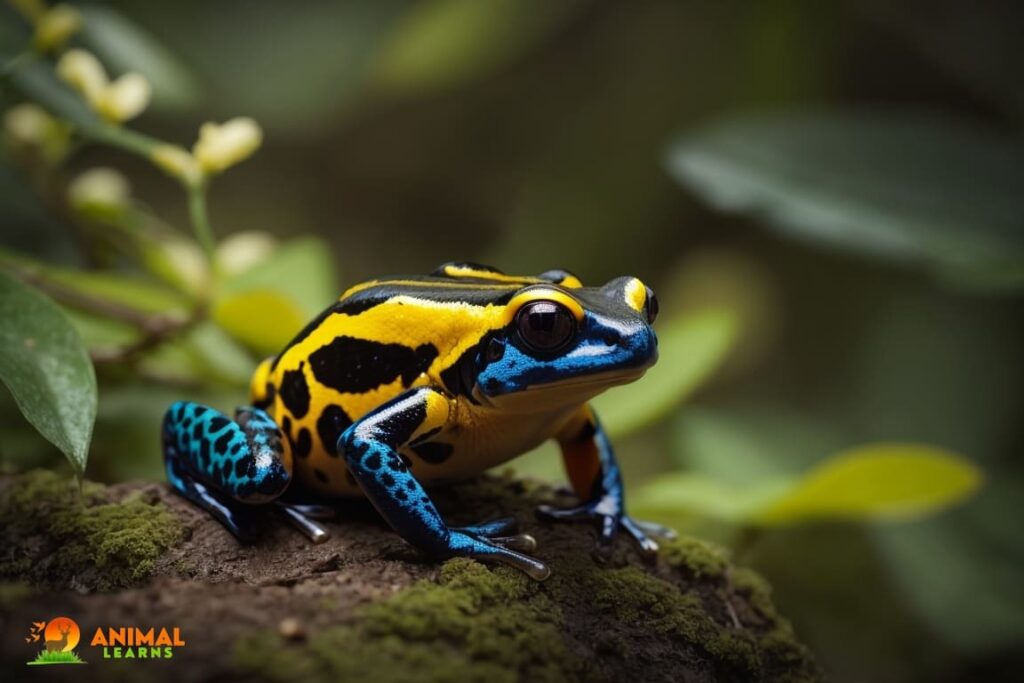
| Information | Details |
| Scientific Name | Dendrobates leucomelas |
| Group | Amphibian (Frog) |
| Habitat | Central and South America |
| Coloration | Bright yellow with black bands |
| Size | About 1.2 to 1.5 inches (3-4 cm) |
The Yellow-Banded Poison Dart Frog, Dendrobates leucomelas, is native to Central and South America. It is renowned for its striking yellow coloration, which serves as a warning to potential predators. These frogs are highly toxic, and indigenous people have utilized their toxins for centuries to poison the tips of blow darts for hunting.
Yellow Canary

| Information | Details |
| Scientific Name | Serinus canaria |
| Group | Bird |
| Habitat | Native to Macaronesia |
| Plumage | Bright yellow |
| Size | About 4.7 to 6.3 inches (12-16 cm) |
The charming Yellow Canary, Serinus Canaria, is one of the yellow animals is a small songbird celebrated for its bright yellow plumage and melodious singing. These birds have been popular pets worldwide, thanks to their vibrant colors and tuneful tunes. Their cheerful disposition has made them a symbol of happiness and positivity.
Yellow-Breasted Chat
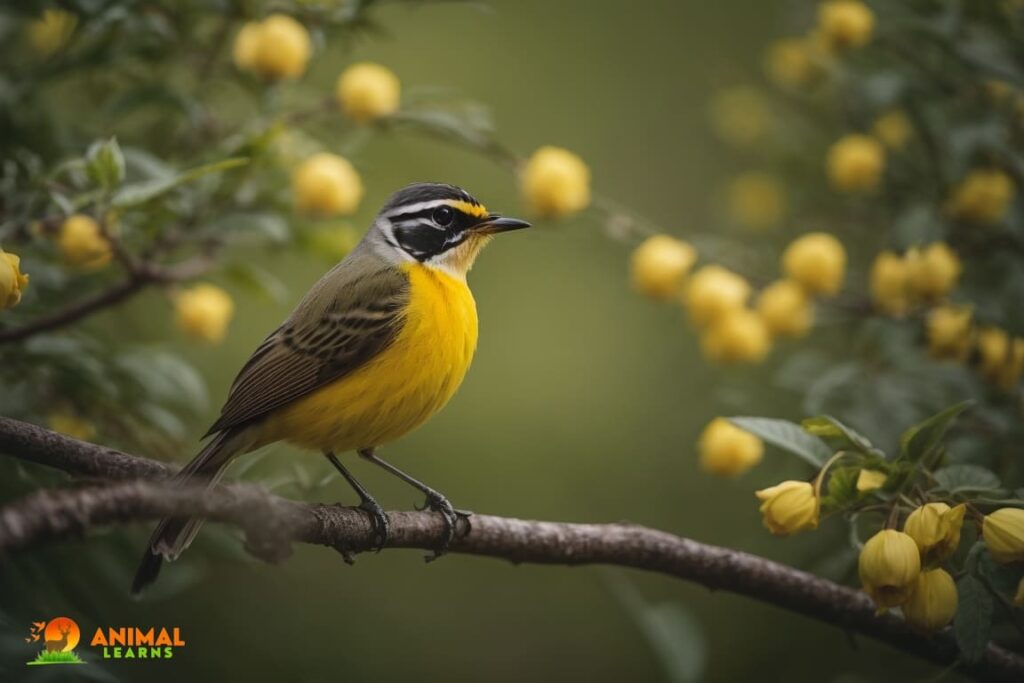
| Information | Details |
| Scientific Name | Icteria virens |
| Group | Bird |
| Habitat | North and Central America |
| Plumage | Yellow breast with various colors |
| Size | About 5.5 to 7 inches (14-18 cm) |
The Yellow-Breasted Chat, Icteria virens, is a North American songbird known for its striking yellow breast and loud, melodious calls. It inhabits marshes and woodlands, where its distinctive vocalizations echo through the dense vegetation. Despite its conspicuous appearance, it can be challenging to spot due to its elusive nature.
Neolamprologus Leleupi

| Information | Details |
| Scientific Name | Neolamprologus leleupi |
| Group | Fish |
| Habitat | Lake Tanganyika, Africa |
| Coloration | Bright yellow |
| Size | Approximately 4 inches (10 cm) |
Dwelling in the depths of Lake Tanganyika in Africa, the Neolamprologus Leleupi is a cichlid fish known for its vibrant yellow and orange colors. These stunning fish add a burst of color to the underwater world of the lake. Their social behavior and intriguing reproductive strategies make them a subject of fascination among aquarists.
Yellow-Crowned Bishop

| Information | Details |
| Scientific Name | Euplectes afer |
| Group | Bird |
| Habitat | Sub-Saharan Africa |
| Plumage | Bright yellow crown and back |
| Size | About 6.7 to 7.5 inches (17-19 cm) |
Found in sub-Saharan Africa, the Yellow-Crowned Bishop, Euplectes afer, is a small passerine bird with a striking yellow crown. During the breeding season, males undergo a transformation, donning vibrant plumage to attract potential mates. Their vibrant displays and acrobatic courtship rituals are a sight to behold.
Common Bluestripe Snapper
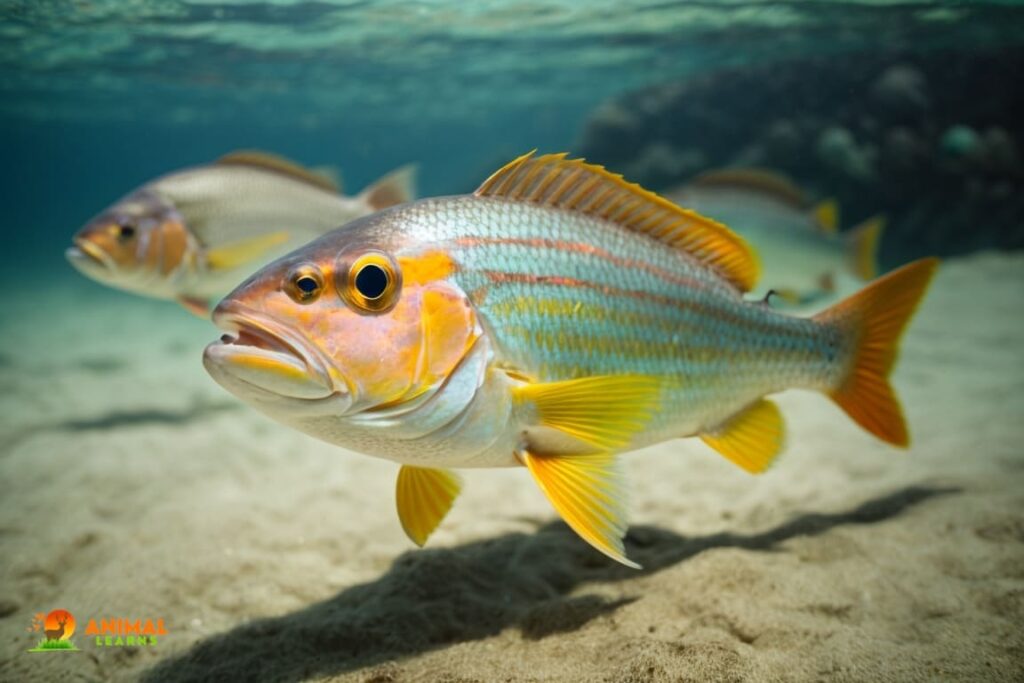
| Information | Details |
| Scientific Name | Lutjanus kasmira |
| Group | Fish |
| Habitat | Indo-Pacific and Indian Ocean |
| Coloration | Yellow with blue stripes |
| Size | Can reach up to 16 inches (40 cm) |
The Common Bluestripe Snapper, Lutjanus kasmira, is a tropical fish that graces coral reefs with its vibrant yellow body adorned with blue stripes. These fish are known for their schooling behavior and are often seen in large groups near coral formations. Their presence adds to the kaleidoscope of colors on the reef.
Brown Basilisk
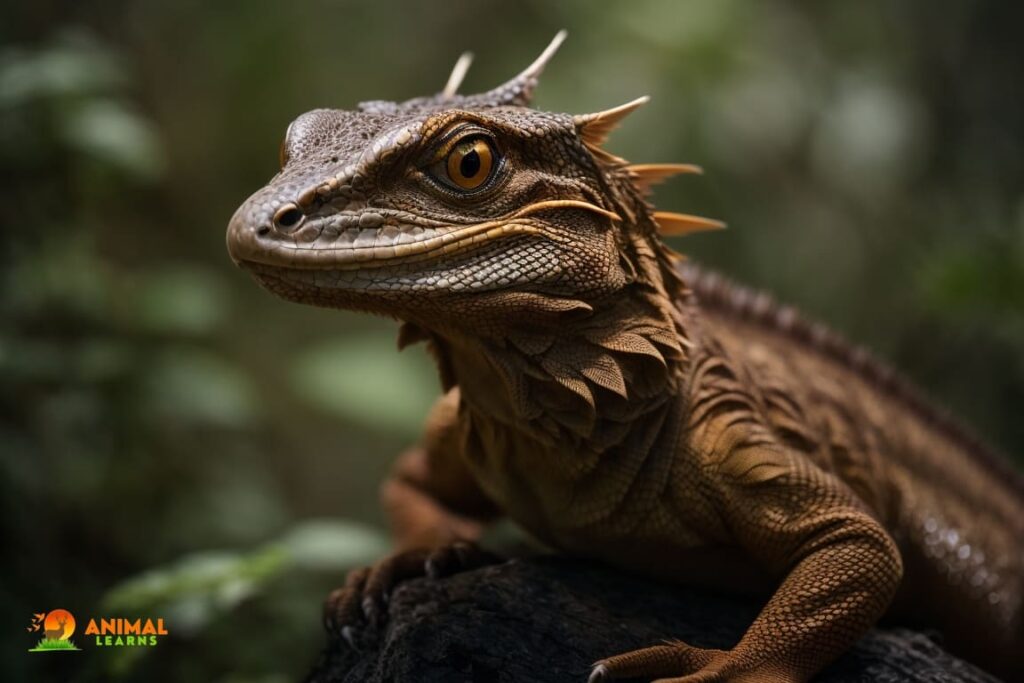
| Information | Details |
| Scientific Name | Basiliscus vittatus |
| Group | Reptile (Lizard) |
| Habitat | Central America |
| Coloration | Brown with yellowish markings |
| Size | About 20 inches (51 cm) |
The Brown Basilisk, Basiliscus vittatus, is often referred to as the “Jesus Christ Lizard” due to its extraordinary ability to run on water. Native to Central America, these reptiles primarily sport brown coloration with striking yellow-green markings on their flanks. Their aquatic prowess allows them to escape from predators by sprinting across the surface of rivers and streams.
Yellow Prawn-Goby
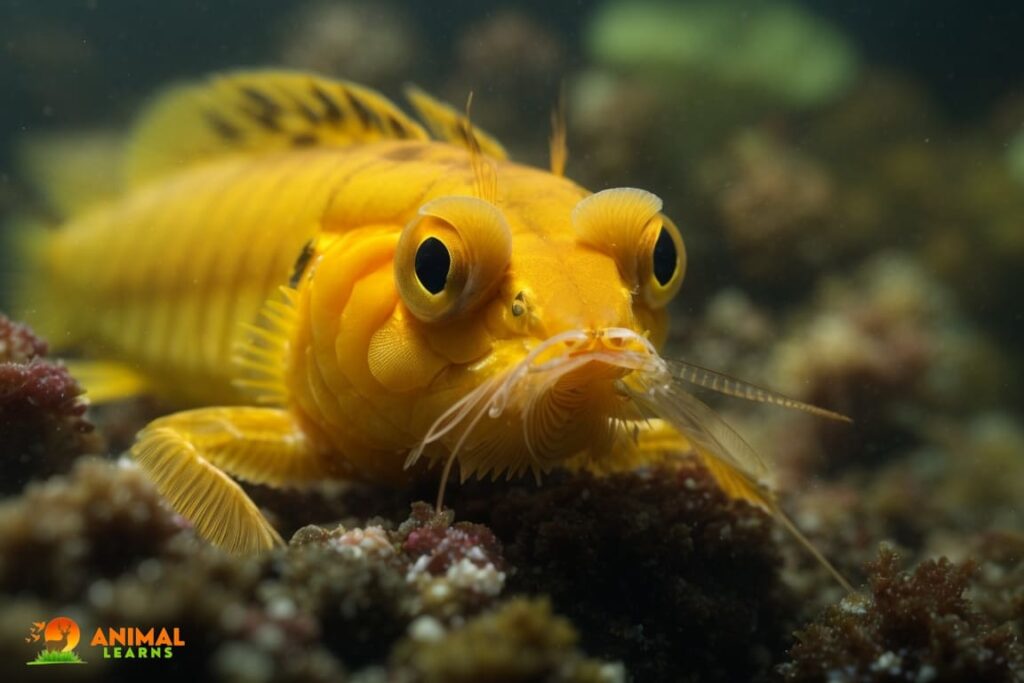
| Information | Details |
| Scientific Name | Cryptocentrus cinctus |
| Group | Fish |
| Habitat | Indo-Pacific and Indian Ocean |
| Coloration | Yellow with blue stripes |
| Size | About 2.4 inches (6 cm) |
The Yellow Prawn-Goby, Cryptocentrus cinctus, is a small marine fish that forms symbiotic relationships with burrowing shrimps. Its bright yellow coloration aids in camouflage as it blends into the sandy substrate of coral reefs. These gobies are known for their diligent burrowing behavior and watchful eye for potential threats.
Notodoris Minor
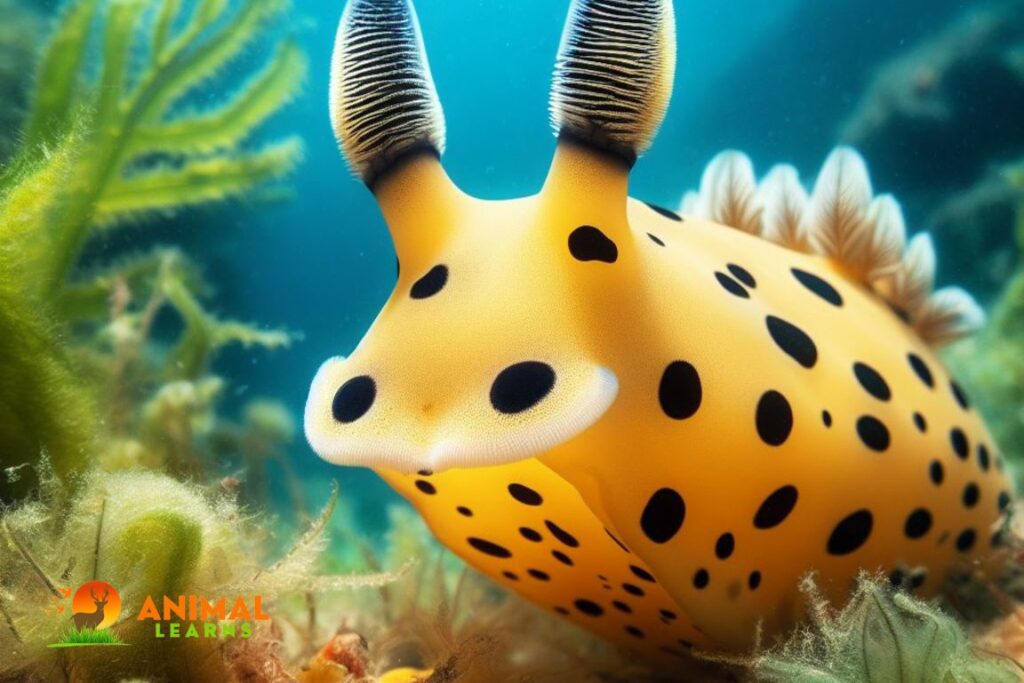
| Information | Details |
| Scientific Name | Notodoris minor |
| Group | Mollusk (Sea Slug) |
| Habitat | Pacific Ocean, Japan |
| Coloration | Bright yellow with white markings |
| Size | Up to 1.2 inches (3 cm) |
Notodoris Minor is a species of nudibranch, or sea slug, found in the Indo-Pacific region. It showcases stunning yellow and orange hues with intricate patterns on its body. Nudibranchs are renowned for their striking appearances and unique adaptations, often incorporating toxins from their prey into their own defense mechanisms.
Ahaetulla Nasuta

| Information | Details |
| Scientific Name | Ahaetulla nasuta |
| Group | Reptile (Snake) |
| Habitat | Southeast Asia |
| Coloration | Green with yellowish markings |
| Size | Up to 5 feet (1.5 meters) |
The Ahaetulla Nasuta, known as the “Green Vine Snake,” showcases a bright yellow-green coloration with a pointed snout. These arboreal snakes are skilled climbers and are often found in trees, where they prey on small birds and rodents. Their slender bodies and cryptic coloration make them excellent hunters.
Lemonpeel Angelfish
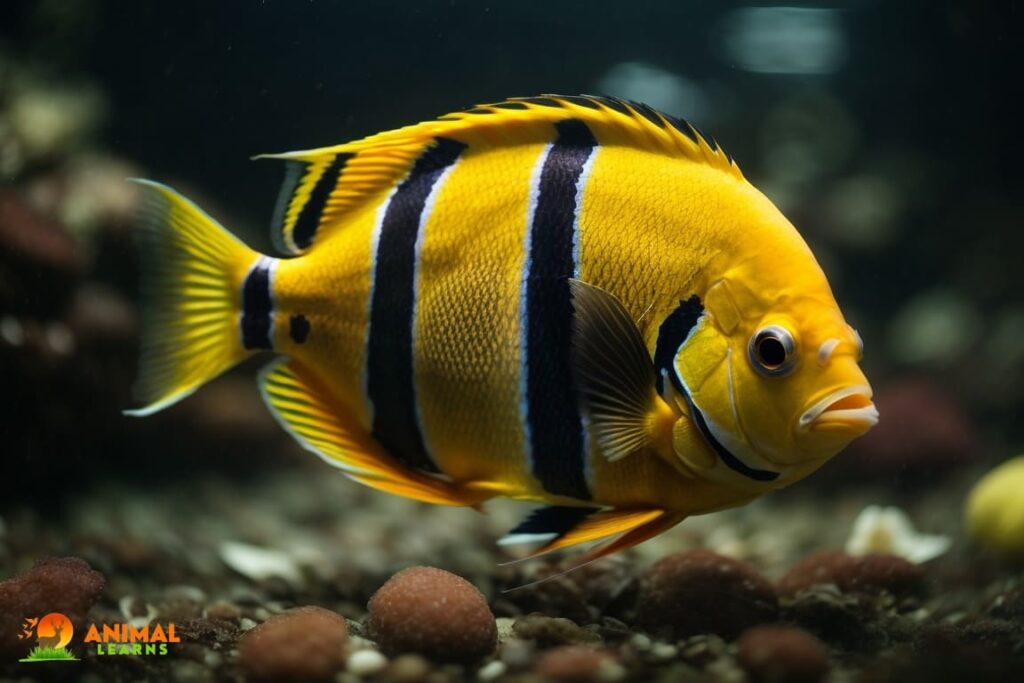
| Information | Details |
| Scientific Name | Centropyge flavissimus |
| Group | Fish |
| Habitat | Coral reefs in the Indo-Pacific |
| Coloration | Lemon-yellow with electric blue |
| Size | About 5 inches (13 cm) |
The Lemonpeel Angelfish, Centropyge flavissimus, is a beautiful marine fish known for its lemon-yellow body and electric blue markings. It adds a splash of color to coral reef environments, where it feeds on algae and small invertebrates. These angelfish are a popular choice for marine aquarium enthusiasts.
Varanus Reisingeri
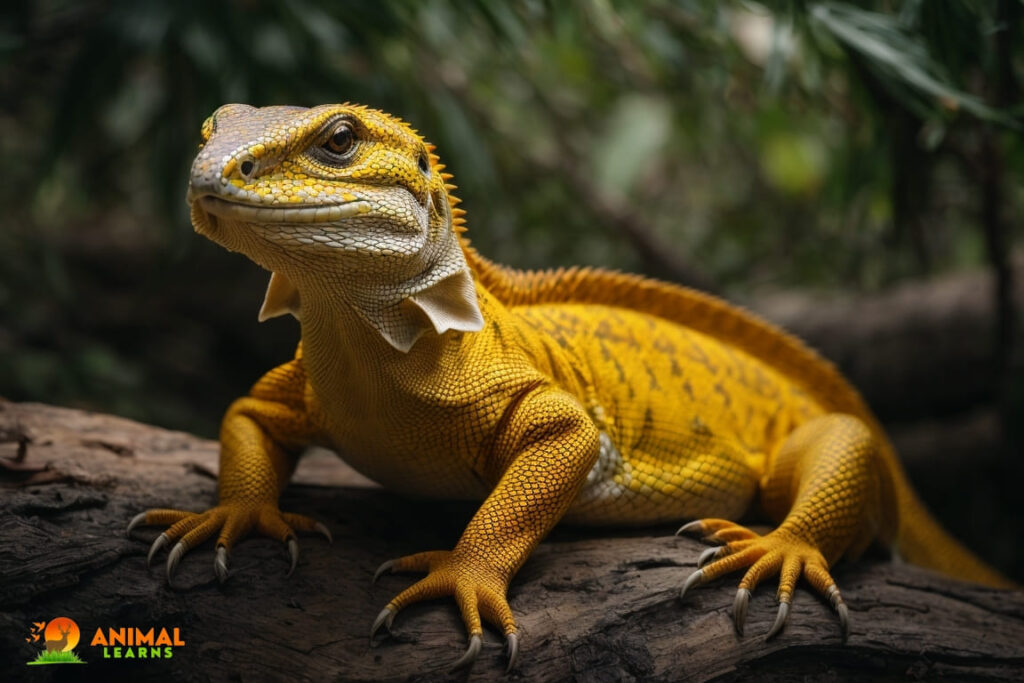
| Information | Details |
| Scientific Name | Varanus reisingeri |
| Group | Reptile (Monitor Lizard) |
| Habitat | Indonesia |
| Coloration | Vibrant yellow with black bands |
| Size | Up to 3 feet (90 cm) |
The Varanus Reisingeri, also known as Reisinger’s Monitor, is a species of monitor lizard found in Indonesia. It boasts a vibrant yellow coloration with bold black bands. Monitors are known for their intelligence and adaptability, allowing them to thrive in various habitats.
Diabrotica Undecimpunctata
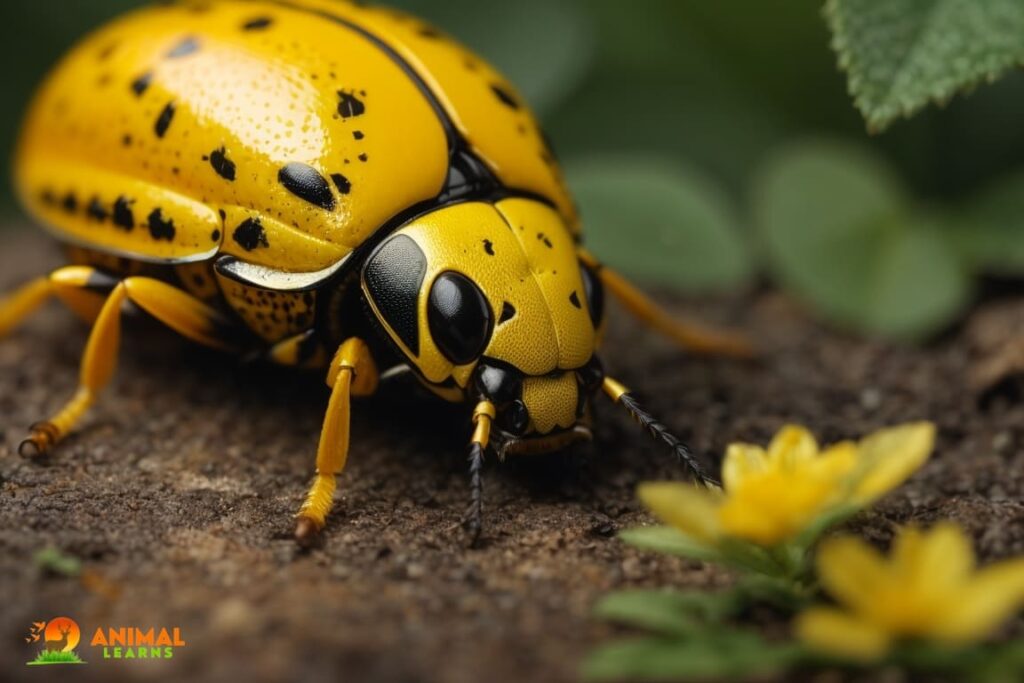
| Information | Details |
| Scientific Name | Diabrotica undecimpunctata |
| Group | Insect (Beetle) |
| Habitat | North America |
| Coloration | Yellow with distinct black spots |
| Size | Tiny, less than 0.2 inches (5 mm) |
The Diabrotica Undecimpunctata, or the “Spotted Cucumber Beetle,” is a small yellow beetle with distinct black spots. These beetles are known for their appetite for cucurbit crops, making them both a pest to farmers and a subject of study in agricultural research.
Phoebis Argante

| Information | Details |
| Scientific Name | Phoebis argante |
| Group | Insect (Butterfly) |
| Habitat | Central and South America |
| Coloration | Bright yellow with black markings |
| Size | Wingspan of about 3 inches (7.6 cm) |
The Phoebis Argante, commonly known as the “Orange-barred Sulphur,” is a butterfly species with vibrant yellow wings adorned with orange markings. These butterflies are often seen fluttering through gardens in the Americas, where they feed on nectar from a variety of flowers.
Old World Orioles

| Information | Details |
| Scientific Name | Various species |
| Group | Bird |
| Habitat | Africa, Asia, Europe |
| Plumage | Bright yellow with black markings |
| Size | Varies by species |
Old World Orioles, such as the Eurasian Golden Oriole, are known for their bright yellow plumage and melodious songs. They are distributed across Asia, Africa, and Europe, enchanting observers with their vibrant colors and sweet serenades.
Sun Conure

| Information | Details |
| Scientific Name | Aratinga solstitialis |
| Group | Bird |
| Habitat | Northern South America |
| Plumage | Bright yellow and orange |
| Size | About 12 inches (30 cm) |
The Sun Conure, Aratinga solstitialis, is a small, colorful parrot native to South America. Its striking yellow plumage, combined with orange and green, makes it a sought-after pet in the avian world. These social and intelligent birds are known for their playful personalities.
Chrysaora Fuscescens
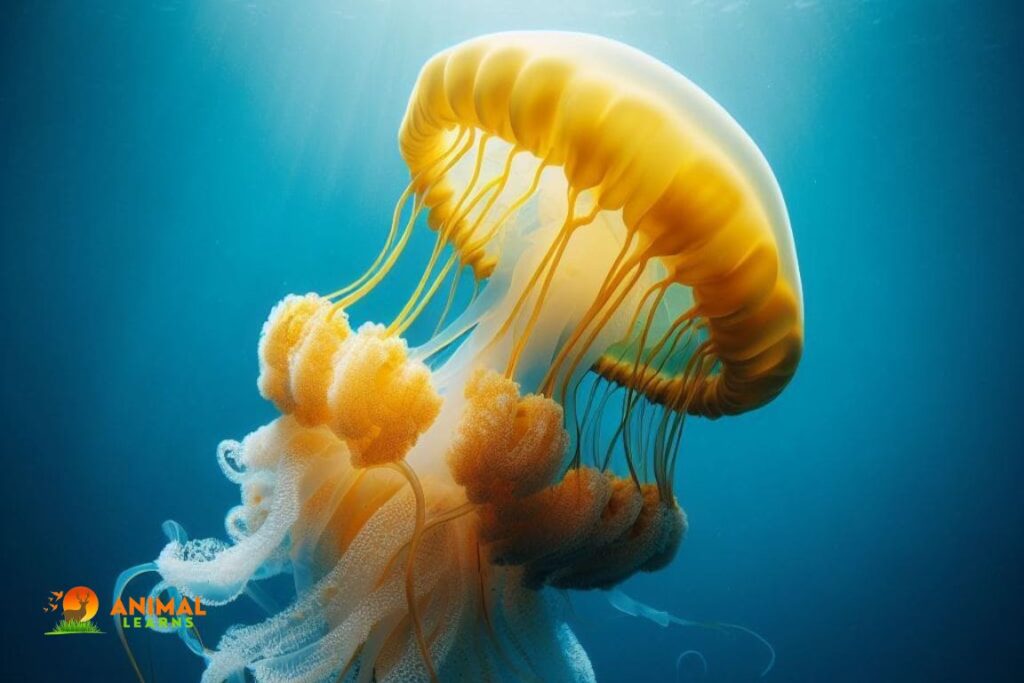
| Information | Details |
| Scientific Name | Chrysaora fuscescens |
| Group | Invertebrate (Jellyfish) |
| Habitat | Eastern Pacific Ocean |
| Coloration | Translucent with yellow-brown bands |
| Size | Bell diameter can exceed 24 inches |
The Chrysaora Fuscescens, known as the Pacific Sea Nettle, is a magnificent yellow jellyfish that roams the coastal waters of North America. Its long, trailing tentacles are equipped with stinging cells, making it a formidable predator. Their graceful and mesmerizing presence in the ocean adds to the wonder of underwater ecosystems.
Sphaerophoria Scripta

| Information | Details |
| Scientific Name | Sphaerophoria scripta |
| Group | Insect (Hoverfly) |
| Habitat | North America |
| Coloration | Yellow with black markings |
| Size | Tiny, less than 0.5 inches (1.3 cm) |
The Sphaerophoria Scripta, commonly called the “Long Hoverfly,” is a tiny insect with bright yellow and black markings. These flies are often seen hovering around flowers, feeding on nectar and pollen. Their resemblance to bees and wasps helps protect them from potential predators.
Sulphur
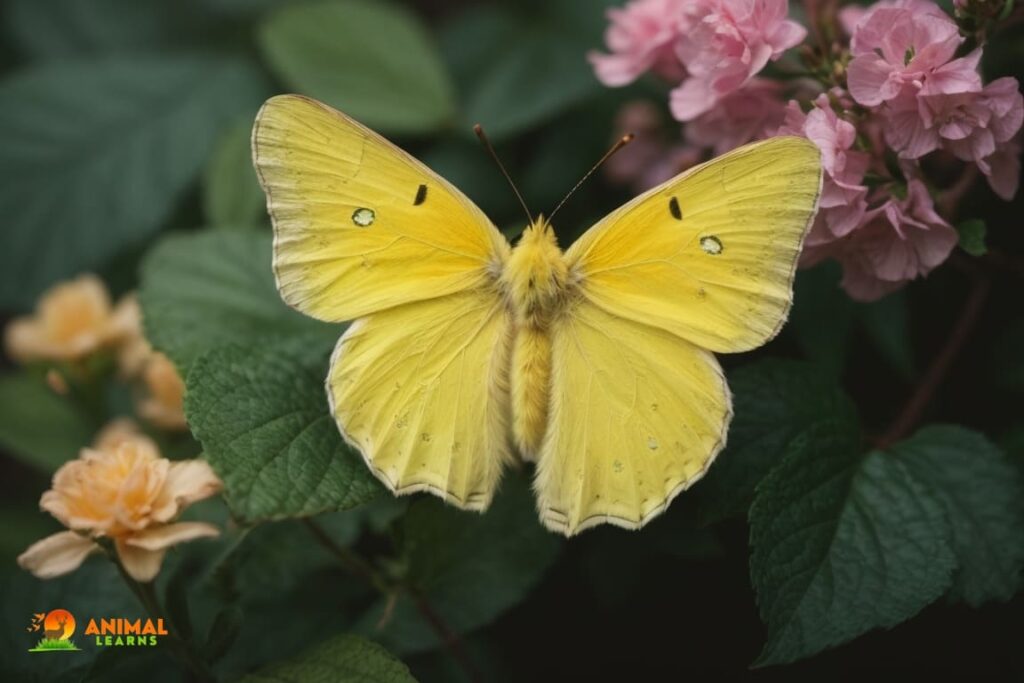
| Information | Details |
| Scientific Name | Colias philodice |
| Group | Insect (Butterfly) |
| Habitat | North America |
| Coloration | Bright yellow with black borders |
| Size | Wingspan of about 1.5 to 2 inches |
The Sulphur, Colias philodice, is a common butterfly species found across North America. With wings adorned in a lively shade of yellow and accented with dark markings, these butterflies are a cheerful presence in gardens and meadows. They serve as pollinators, playing a vital role in the ecosystem.
Electric Yellow Cichlid

| Information | Details |
| Scientific Name | Labidochromis caeruleus |
| Group | Fish |
| Habitat | Lake Malawi, Africa |
| Coloration | Bright electric yellow |
| Size | Up to 4.5 inches (11 cm) |
The Electric Yellow Cichlid, Labidochromis caeruleus, is a popular freshwater fish in the aquarium trade. Its dazzling yellow coloration and peaceful demeanor make it a favorite among hobbyists. These cichlids are native to Lake Malawi in Africa, where they inhabit rocky habitats.
Butterflyfish

| Information | Details |
| Scientific Name | Various species |
| Group | Fish |
| Habitat | Coral reefs in tropical oceans |
| Coloration | Bright yellow with black patterns |
| Size | Varies by species |
Butterflyfish are a family of colorful marine fish found in tropical oceans. Many species display vibrant yellow patterns on their bodies, adding to the beauty of coral reefs. These fish are not only visually stunning but also play crucial roles in reef ecosystems by consuming algae and coral polyps.
As we’ve embarked on this journey through the world of 50 unique yellow animals, it’s evident that the natural world is a canvas painted with vibrant hues. These captivating creatures, whether soaring through the skies, crawling across the ground, or swimming in the oceans, bring a splash of sunshine wherever they go.
Whether you’re a nature enthusiast or simply appreciate the beauty of the animal kingdom, these yellow animals remind us of the rich tapestry of life on Earth.
The Allure of Yellow in Nature
Within the domain of Miscellaneous Yellow Keywords, a plethora of captivating topics comes to light, spanning from yellow overalls costumes to endearing yellow animals. These colorful depictions underscore the undeniable allure of yellow within the animal kingdom.
But why exactly are animals yellow, and what is the origin of the name “yellow”? These are inquiries that have piqued the curiosity of many. Certain animals, adorned with black spots, epitomize the remarkable contrast between yellow and other colors in the natural world.
The Virtual and Real World of Yellow Animals
In the virtual realm of the Animal Crossing game series, players encounter a vibrant universe where they can interact with an assortment of animals, including yellow-hued cats and squirrels.
As we immerse ourselves in the taxonomy of yellow animals and the diversity of their species, we’re reminded of the intricate tapestry of life on our planet. From the yellow snake featured in Animal Jam to the yellow tiger that roams the world of Animal Crossing, these creatures, both virtual and real, continually captivate our imagination.
Whether it entails spotting yellow animals in the wild or appreciating their exceptional characteristics, the realm of yellow animals is a captivating and multicolored one.
FAQs
What animal is yellow in color?
Many animals can be yellow in color, such as the American Goldfinch and the Yellow Tang fish.
What yellow animal is endangered?
The Panamanian Golden Frog is a yellow animal that is endangered.
Why are some animals yellow?
Some animals are yellow as a result of their genetics and pigmentation. Yellow can serve various purposes, including camouflage, warning signals, and attracting mates.
What is yellow in the natural world?
In the natural world, yellow is a color that can be found in flowers, fruits, birds, insects, reptiles, and many other living organisms.
What is the rarest color of animals?
Blue is often considered the rarest color in animals, as it is less common in the animal kingdom compared to colors like brown, green, and yellow.

